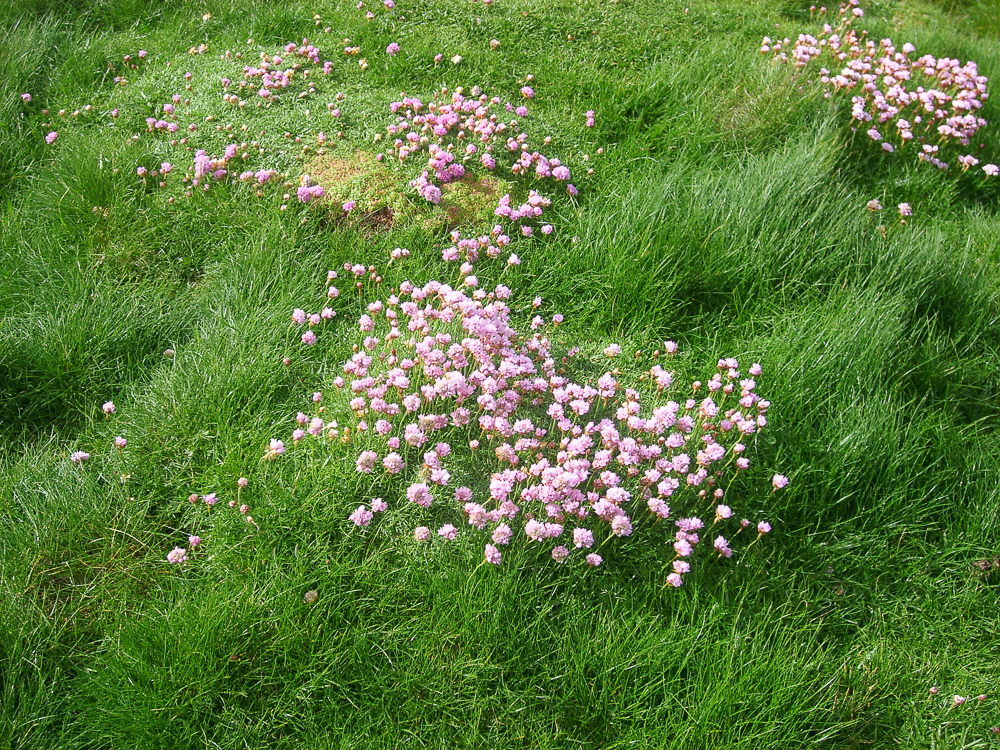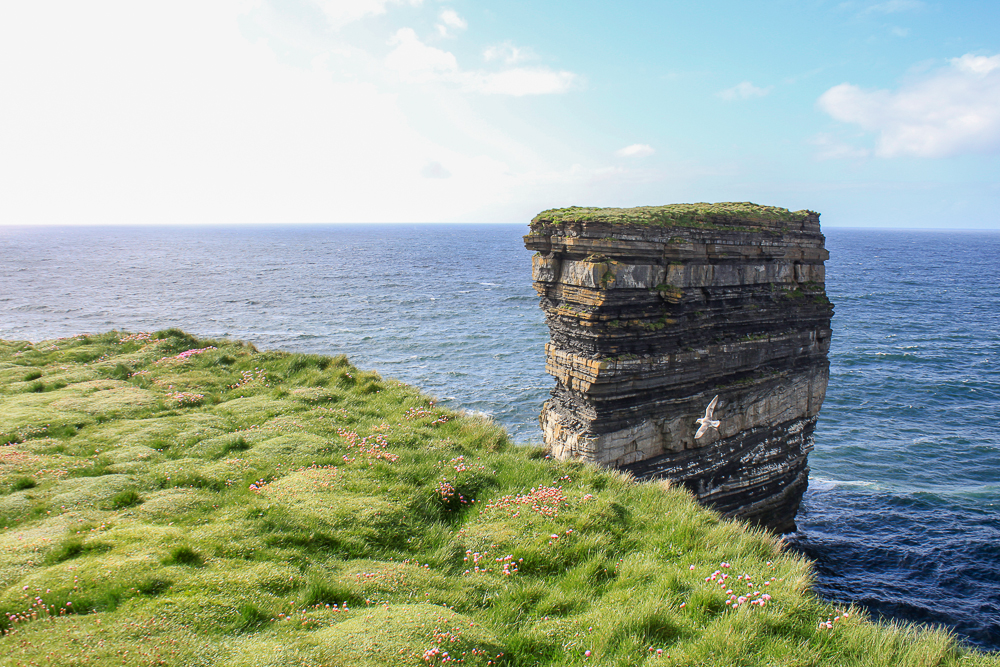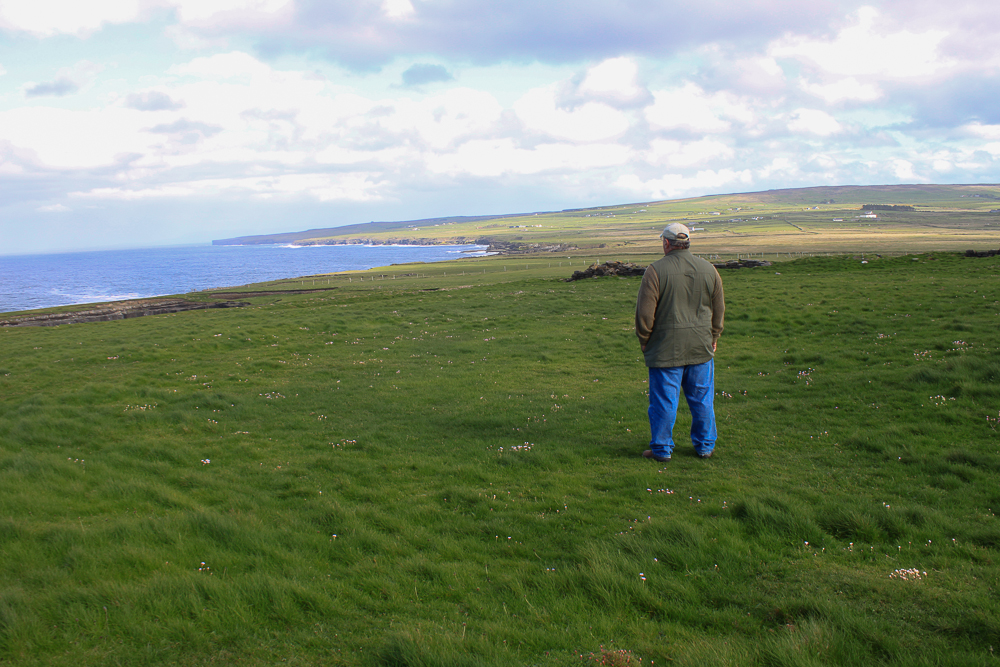Happy Candlemas – St Brigid’s Celebration
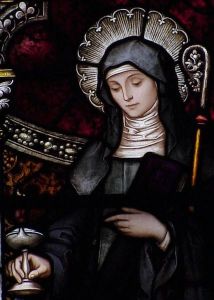
Happy Candlemas!
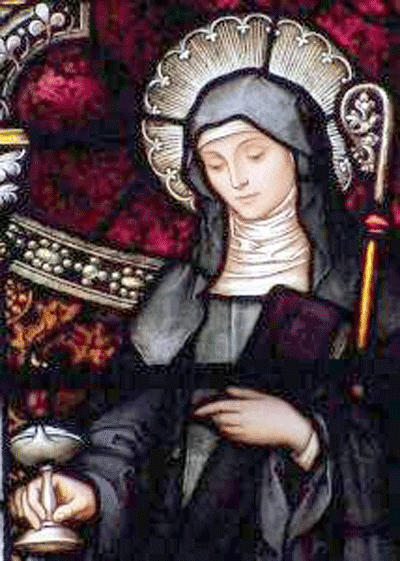
St. Brigid stained glass window
February 2nd – 02/02 – The feast of the flames – the bringing of the light.
This is also the Christian feast of the Presentation of the Lord Jesus in the Temple – the 40th day of the Christmas season.
So many cultures mark this day as a day to think of spring, of the thawing of the earth, the ending of the darkness, the long nights, the coming of the light. We think of St. Brigid of Kildare – Brigid the saint who brought the light of the Word, bread for the poor, peace to the troubled and welcome to the stranger whose feast day – February 1st is part of the “light” celebration.
Tree of the Day series
This is also the day I start a “Tree of the Day series” where I will post images of trees in thin places I have visit. These are special trees – fairy trees, healing trees, trees of mystery, trees associated with stories.
The Tobar Bhride Tree – Kildare
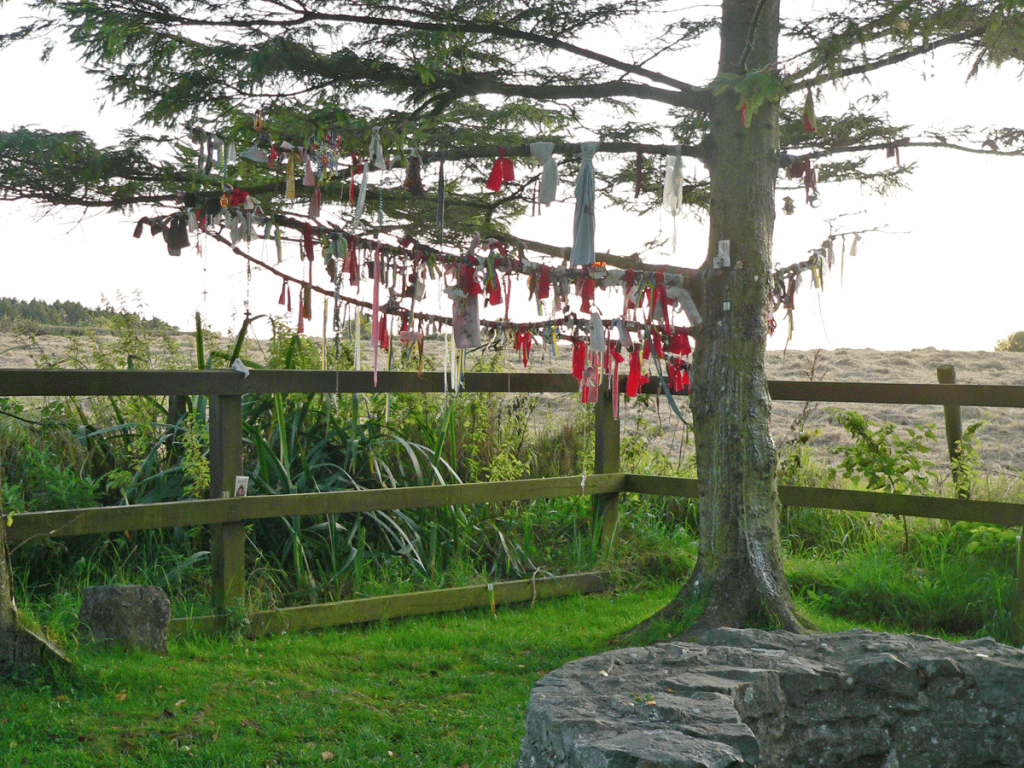
The tree at Tobar Bhride – Kildare
Today I’ll give you the tree at Tobar Bhride (Brigid’s Well) in Kildare. Local people and pilgrims from all over the world visit this well and the tree beside it bringing their prayers of devotion, special intentions and hearts full of thanksgiving for prayers answered.
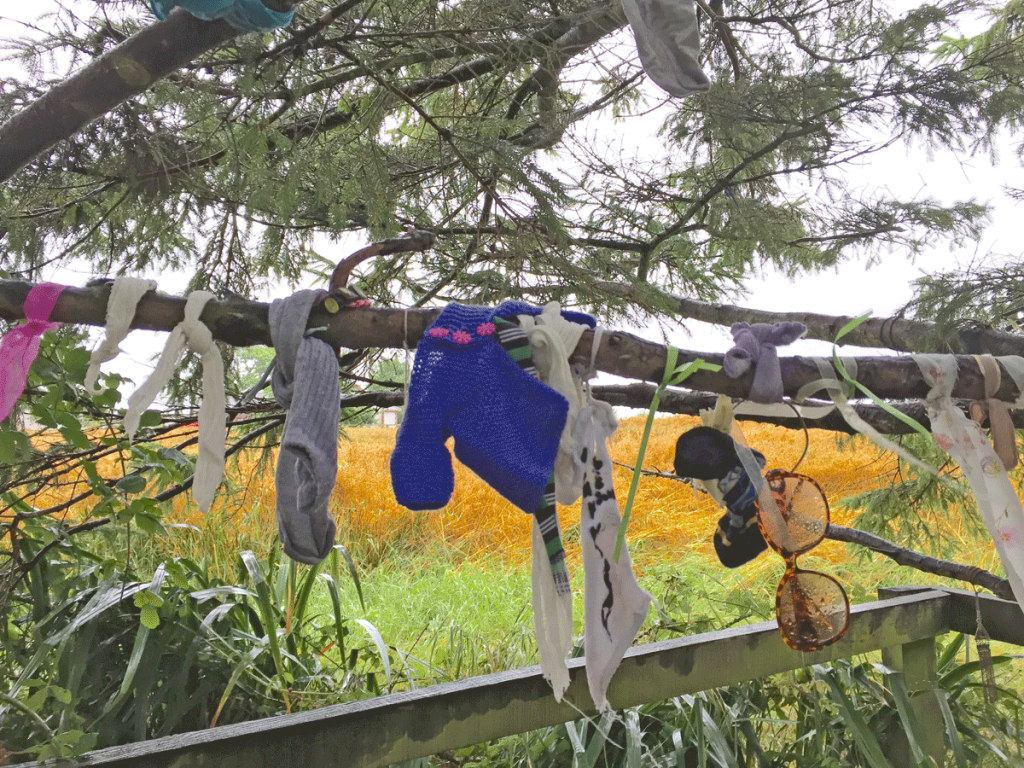
Tokens – “clooties” left on the branches.
As a sign of devotion, the faithful who visit the well sometimes leave a physical reminder of their prayer behind by tying a rag to the tree beside the well. Sometimes they leave something else of meaning behind – a possession of the person for whom they are praying, a photo, a prayer card. These tokens are called “clooties” and the lower branches of the Tobar Bhride tree is covered with them. Some of the clooties pull at the heart of the observer. .. pictures of sick mother, baby shoes, hair ties, little toys.
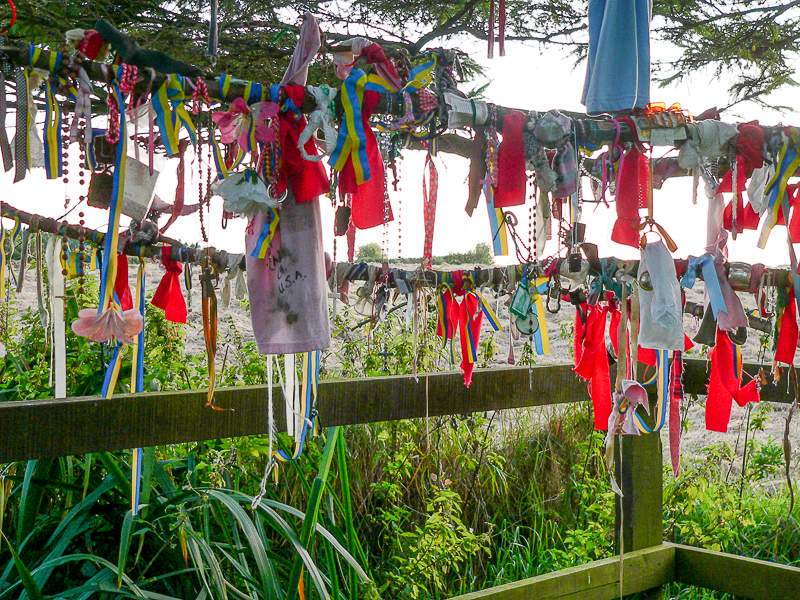
Clooties at Tobar Bhride Kildare
The local people who care for the well and its garden remove the clooties regularly to make way for more. According to the locals, the clooties are buried nearby. One cannot stand by the Tobar Bhride tree and not be moved. It has a quiet but powerful energy.
This tree, the holy well and the Solas Bhride center are a stop on the Discover the North, Castles & Saints and Trail of the Hag tours.
Downpatrick Head Ireland
Downpatrick Head in Ireland is on the north coast of County Mayo. It was named for St. Patrick because he is believed to have built a church there, and there still are remains of an old church and a stone marker that supposedly shows where St. Patrick’s original church stood.
Downpatrick Head Ireland
As you approach Downpatrick Head the land opens up in a vast plateau overlooking the wild Atlantic Ocean. You are walking into one of the many “wild places” in Ireland. Even the most boisterous of travel groups will become quiet as they approach the cliffs. The landscape pulls each person into a walking meditation. It almost demands silence.
There’s a lovely cliff walk where one can survey the crashing waves of the Atlantic Ocean against the patterned cliffs while hundreds of birds roost in the crevices and swoop and dive all around the cliffs. We were there in May when the “sea pinks” were in bloom and we couldn’t resist taking pictures of them on the cliff tops.
We spent the morning in this magical thin place never noticing the passing of time.
There is also a holy well and a memorial to 25 Irishmen who fled from British Redcoats during a 1795 uprising. They hid in the caves at Downpatrick Head, but couldn’t get back out before the tide came in and flooded the cavern. They all perished.
But Downpatrick Head is best known for Dún Briste (Broken Fort) or “the sea stack” which is an outlying stone stack just off the cliff face. The landscape there defines “wild” which is so common to the West of Ireland.
Dún Briste – (broken fort) the sea stack is the landmark most associated with Downpatrick Head in Ireland on the north coast of County Mayo.
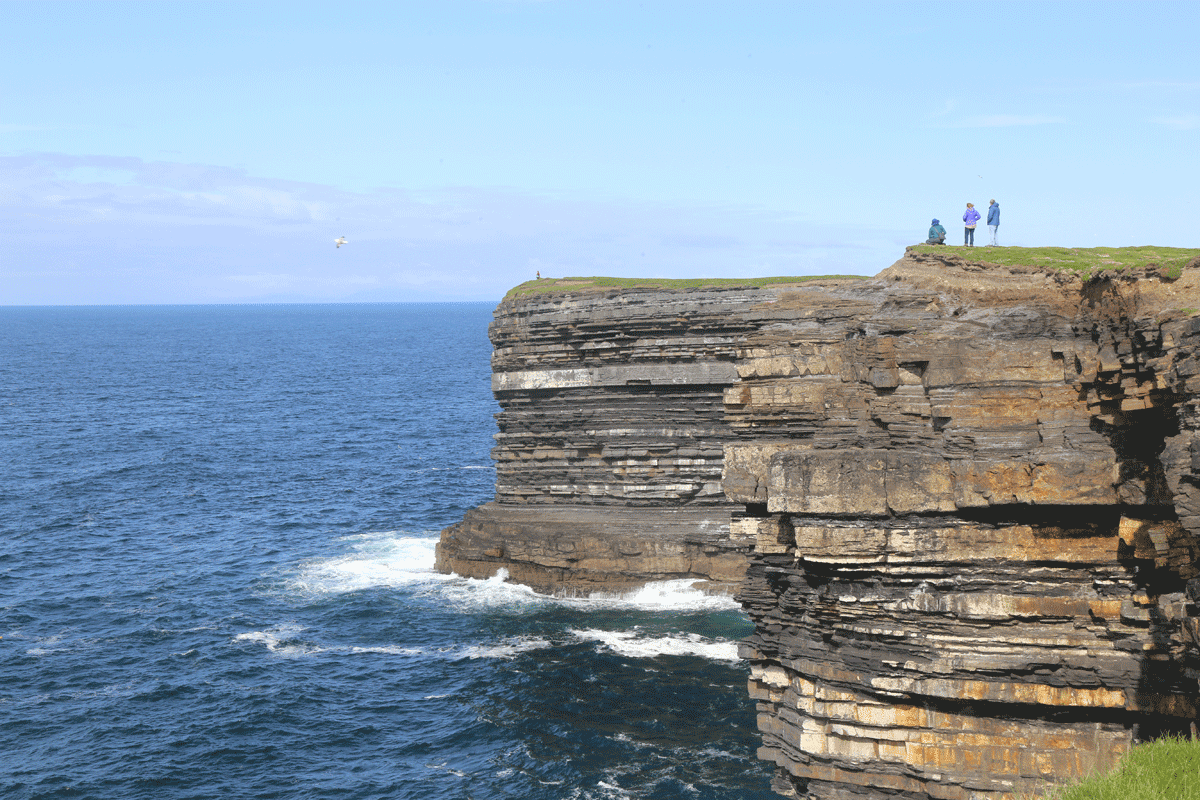
My mind frequently wanders to Ireland. In those rare, still, moments when I can close my eyes and imagine certain places, I almost always go to Ireland. In my imagination, I often place myself at Downpatrick Head. I contemplate the time change – Is it daylight or night time? Where is the moon (or sun)? Is it raining, cold, warm? Are the flowers peeking through the grass? I hear the sound of the waves, the wind, the birds. I feel the damp air. In my mind, I notice all of the details.
Once I settle into that landscape in my mind, the colors take over, then the sounds, then finally — the wind. It seems there’s always wind blowing in Ireland.
I’m reading a fantastic new book by Robert Macfarlane entitled Landmarks, which is about the language that developed around elements of the landscape in the UK and Ireland, and the power of “landscape language.” McFarlane comments in the very first chapter about language shifts that move away from nature and toward technology.
“…Under pressure, Oxford University Press revealed a list of the entries [in the new Oxford Junior Dictionary] it no longer felt to be relevant to modern-day childhood. The deletions included acorn, adder, ash, beech, bluebell, buttercup, catkin, conker, cowslip, cygnet, dandelion, fern, hazel, heather, heron, ivy, kingfisher, lark, mistletoe, nectar, newt, otter, pasture and willow. The words introduced to the new edition included attachment, block-graph, blog, broadband, bullet-point, celebrity, chatroom, committee, cut-and-paste, MP3 player and voice-mail.”
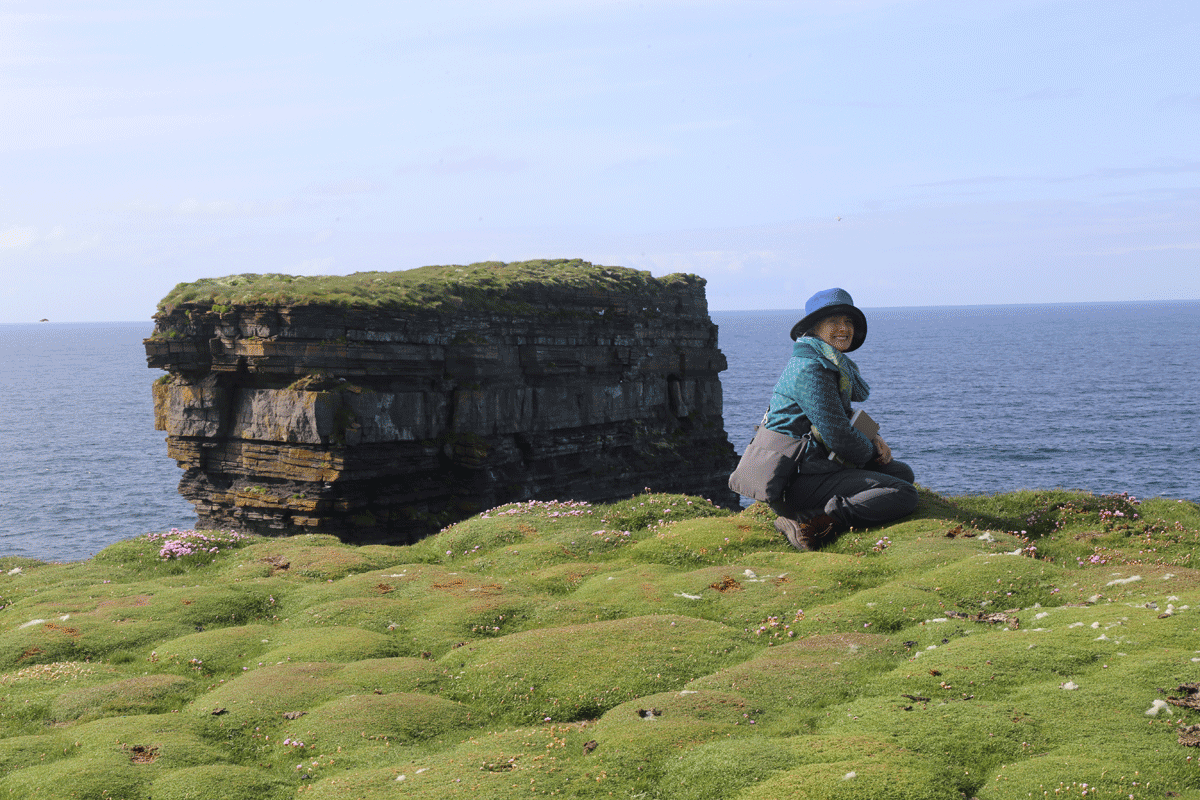
I plead guilty to loving technology, gadgets and the amazing world of telecommunication, but I’ve never embraced it at the expense of stopping and noticing the details in nature.
Sheep roam all over the cliffs at Downpatrick Head … just as they’ve been roaming for centuries. I wonder if they notice the details. Probably not.
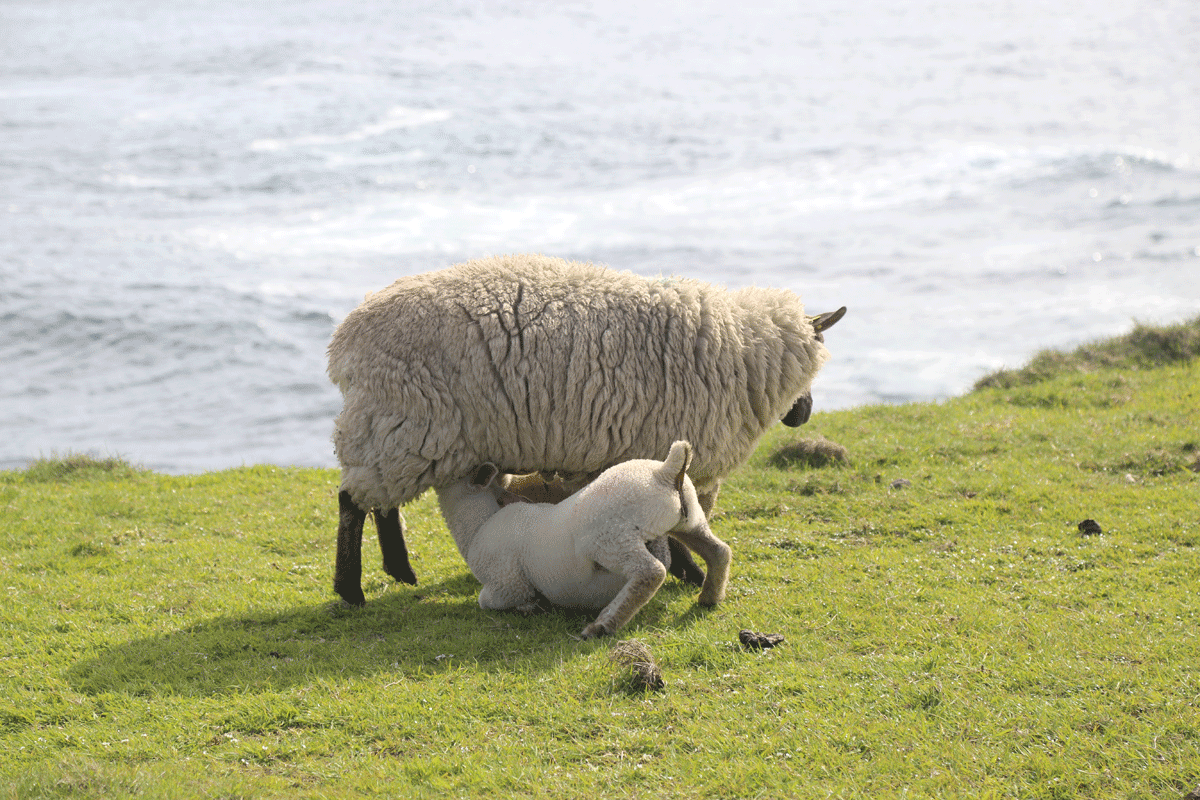
Downpatrick Head Sheep
Here’s to March … and here’s to Spring … and here’s to noticing the details. Those details – the things we only notice when we stand still and look – are the things that connect me to the thin places.
We explore Downpatrick Head is on some of our Thin Places Tours of the Wild Atlantic Way in Ireland.
Photos by Dan and me (Mindie Burgoyne). Special thanks to Joe McGowan and John Willmott who helped identify “sea pinks” and their healing properties.
The Man in the Sand in the Shadow of Mount Brandon
A Man in the Sand Appears on the Beach near Mount Brandon in Dingle
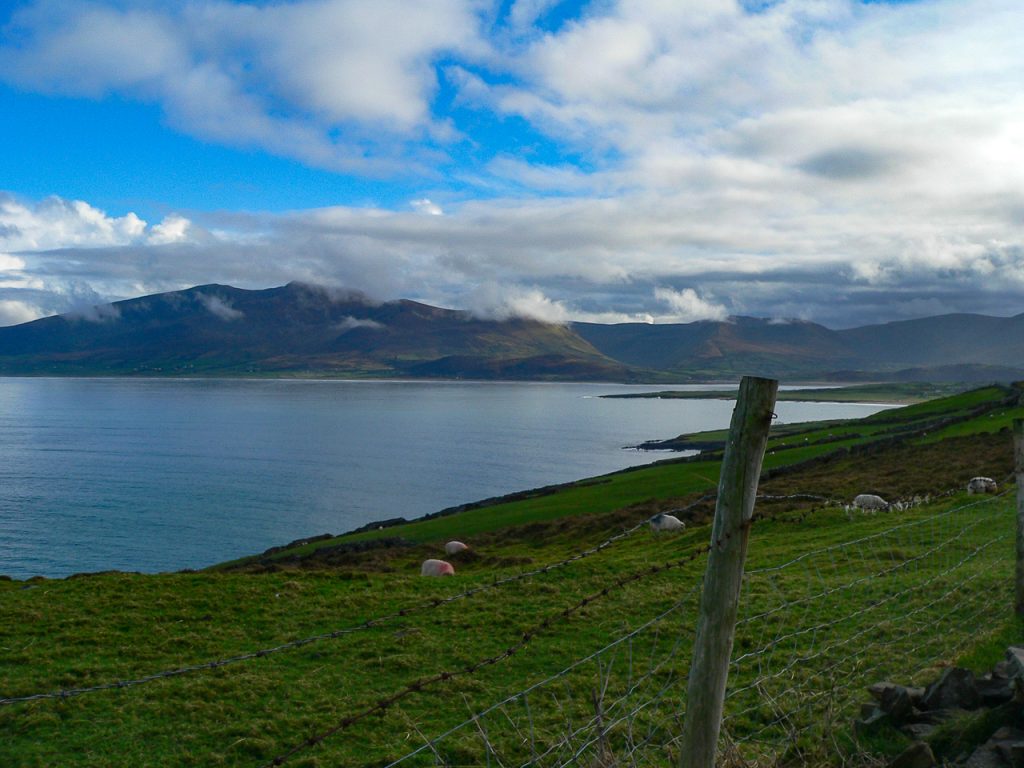
On a dreary February day many years ago, I was traveling alone in Ireland, doing some research for some writing I had to do on thin places in Ireland. Most of this day was spent on St. Brendan the Navigator who was born near Dingle and is a local heroic figure. I visited Ardfert, his first monastery, then Mount Brandon – the holy mountain named for him.
I was in a bad place personally when I wrote this travel journal entry. I’d been working on completing this book for years and I couldn’t move myself forward. No amount of research could push me to completion. Every time I started, I stopped. I had no confidence – filled with self doubt.
This was also a day of miracles – or coincidences. There’s something different about praying in a thin place, though. If you listen hard enough, sometimes you hear an answer or get a sign. This a day for one of those knock-you-in-the-head burning bush signs.
Travel Journal entry – February 20, 2009 – Ireland, Co. Kerry
Mount Brandon – coming from the north road into Dingle after passing the exits for Castlegregory, I came to Fermoyle strand. Mount Brandon dominates the landscape on all the north roads.
Mount Brandon is the second tallest mountain in Ireland and at its base, St. Brendan the Navigator is said to have launched his fleet of curraghs to set sail for the Promised Land as revealed to him in a vision. Prior to the voyage, he spent time on this holy mountain-top in reflection and prayer similar to St. Patrick’s retreat on Croagh Patrick. Also similar to Croagh Patrick, it’s likely that both holy mountains were considered sacred by the local people long before Christianity came to Ireland.
To say the scenery here is breathtaking would understate. It’s magical. The dismal sky and drizzle offered a blue-gray backdrop, but allowed just enough sunlight to illuminate the vivid green fields dotted by sheep at the base of the mountain. Down on the strand the wet sand at the shore is firm – almost like slate. The waves rush in and then Atlantic sucks the surf back out almost a half a mile – leaving various shapes in the flat sand. I was the only one on the strand. The only human image in that landscape.
I pulled into a little car park for people walking out to the beach. It started to rain buckets. So I sat in the car for awhile reading over notes and other authors’ writing about thin places in Ireland. I opened up an article by a well-known author – one whose work had appeared on the New York Times Best Seller list. Though I loved this author’s works of short fiction, I was disappointed in how sappy and trite this piece on thin places was. The writer overtold the meaning. The work left me feeling the writer was trying more to project a sense of spiritual superiority than remark on the mystery of a thin place.
I’m so judgy.
I thought to myself, “how is it that this successful author can get stuff like this published about this places, and I can’t write a word?”
Rain stopped. I continued my indulgence in self-pity as I walked out onto the strand. The tide was out and the sand seemed to stretch on forever. Mount Brandon dominated the landscape. I noticed a pale light hanging it illuminating a very low, wispy cloud just touching the peak. I was then then I stepped into the moment – feeling no passing of time… just being.
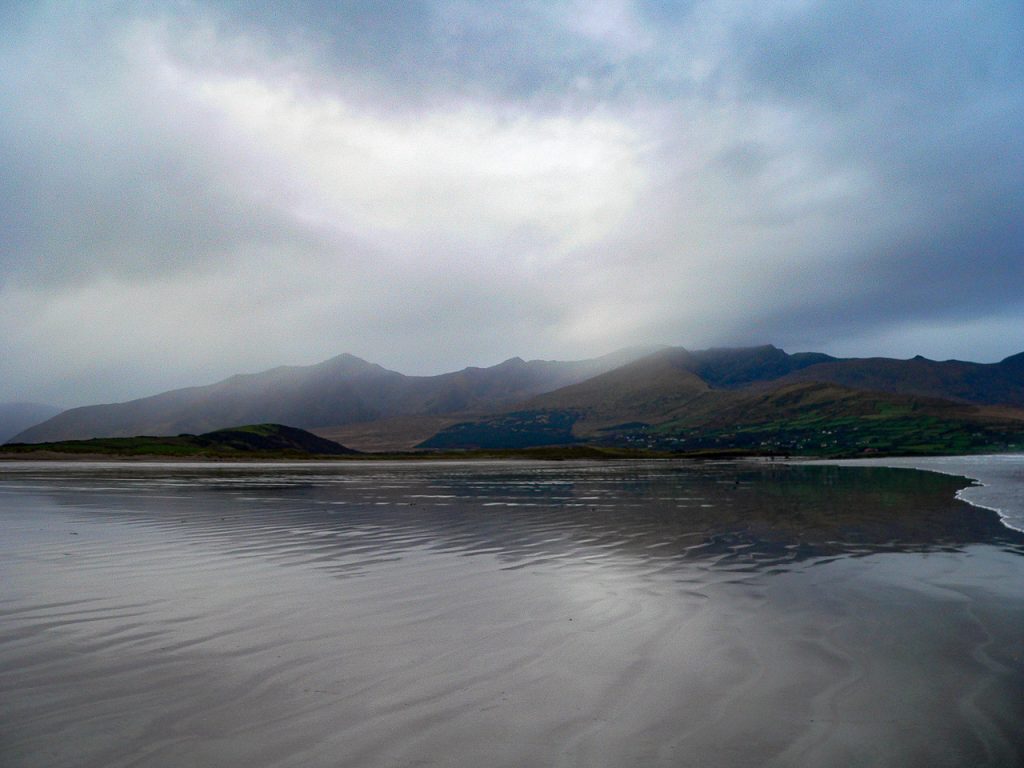
With a great sense of inadequacy, I turned to God, or whoever might be listening and said, “I can’t write. No matter how hard I try. I can’t write.”
My one-sided conversation was pretty anti-climactic. But then I looked down at the sand. There was an image created by the receding waves. It seemed to have a head, body, legs, and its right hand was extended with what looked like a flower or a box or something. It looked like a faceless man in a cloak. I thought, “Am I really seeing that? I’m just imagining that it looks like a man in the sand. But it didn’t wash away or fade away. So I started snapping pictures.
Even after fifteen minutes the man in the sand was just as clear as he was when I first noticed him. At times like this, I guess we try to find meaning. Was it a sign? Did it mean something? If so, what? I was reluctant to ascribe any meaning to the man, but it sure felt like …. something.
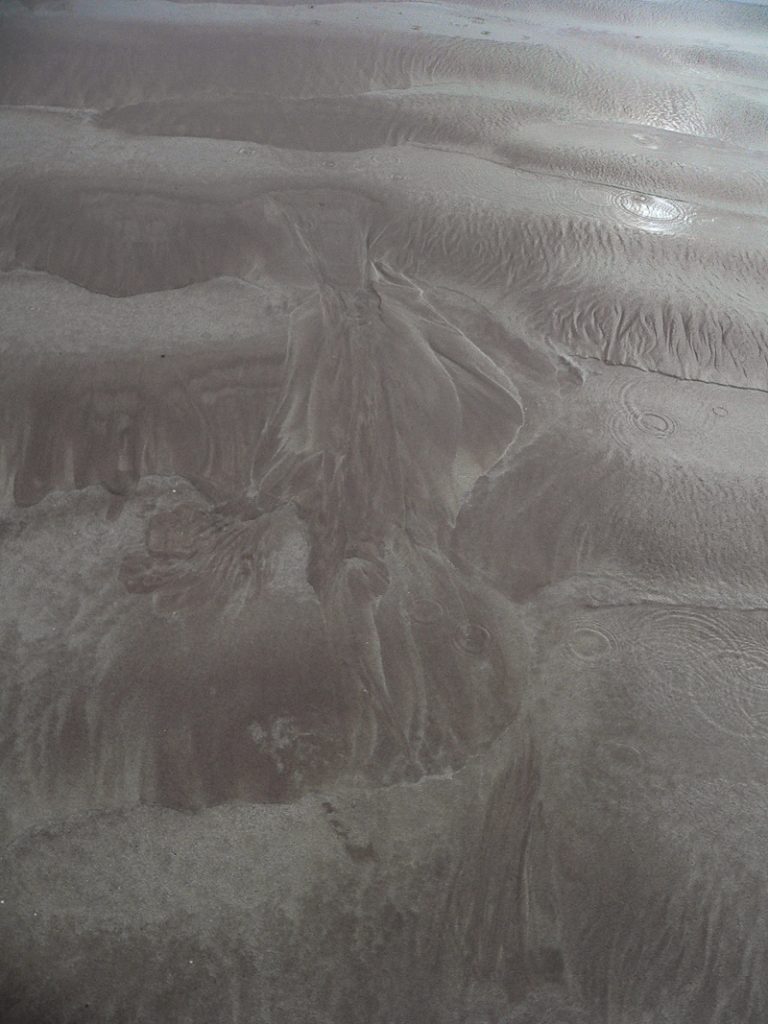
It was surely a synchronistic moment.
Caitlin and John Matthews remind us that we communicate with our five senses in the physical world, but we communicate with our spirit in the spirit world. They also give us insight on how to perceive coincidences moments of synchronicity – the simultaneous occurrence of events that appear significantly related but have no discernible causal connection. Here’s a quote referencing this from their book, Walkers Between the Worlds.
“… synchronicity… is actually an instance of an exact match between the fabric of our world and that of the Otherworld. While we normally dismiss such an occurrence as coincidental, in looking more deeply we can see the exact correspondences between one world and the other.”
After I was done with my man in the sand, I turned to leave. I was headed by car to the foot of Mount Brandon. There’s a road that winds around past Brandon village and ends at a place called Ballydavid north. It’s as far as you can go around Brandon Bay and the road ends at a little car park where one can take off up the mountain on foot. The rain was coming back and about to pour. The sky was black. As I turned to leave the beach I notice a bright ribbon of a rainbow in the eastern sky. Wow.
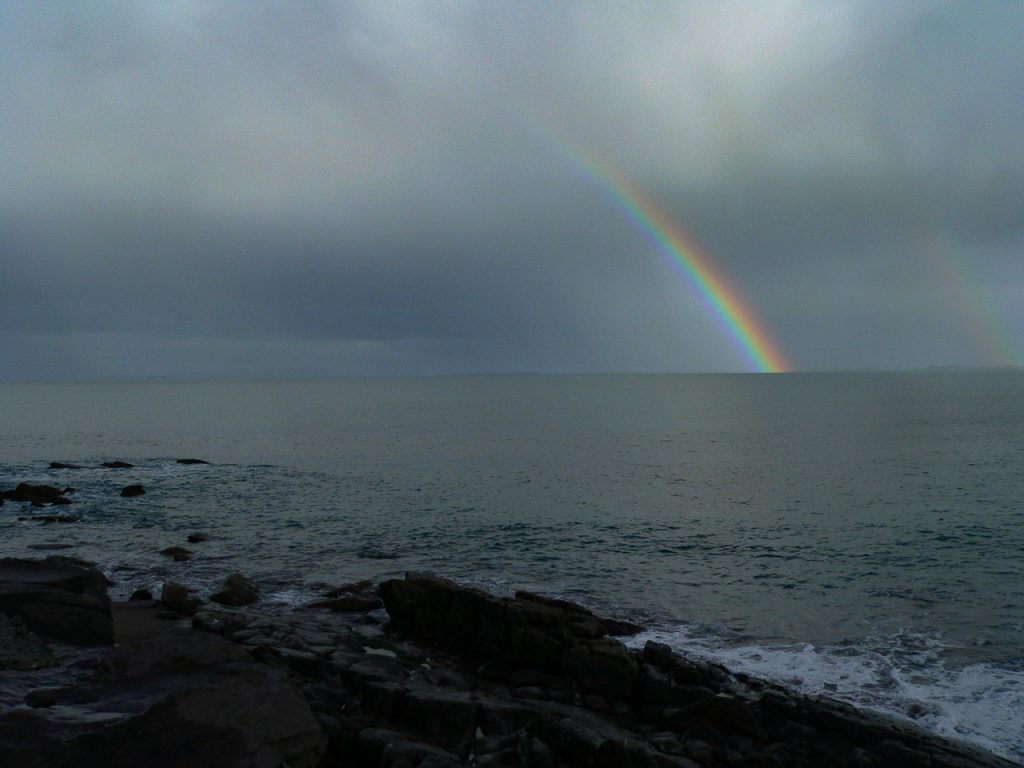
Another sign? Maybe. Maybe another coincidence.
I got to the car and headed out. For 20 minutes I drove and for 20 minutes that rainbow followed me. It was still there when I got to the foot of Mount Brandon. And I stayed there another twenty minutes as the rain fell and the sky cleared … watching it fade away. What a day.
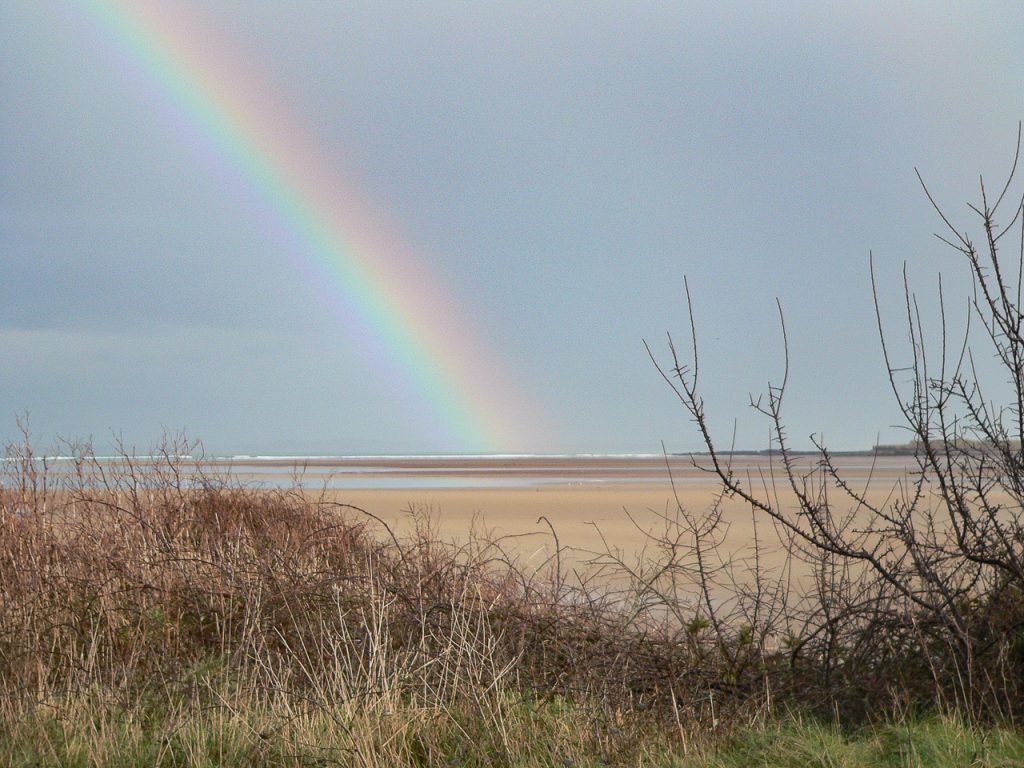
The eternal world or spirit world or Otherworld is one side of reality while our physical world is the other. But together they show us one world, one reality. A thin place brings us face to face with these two sides of one reality, and our prayers – our conversations with the Creator are whole and enjoy a sense of completeness.
Fermoyle Strand and Mount Brandon are thin places. At the time I was experiencing the above-mentioned synchronicity in Dingle I didn’t understand what any of it meant. Thus the importance of journaling and taking photo images. As we grow in spirit, so does our understanding.
And when I got home … I couldn’t stop writing. I’m still writing.
Inchmahome Forest Walk – Stirlingshire, Scotland
Inchmahome Forest Walk Ancient Trees
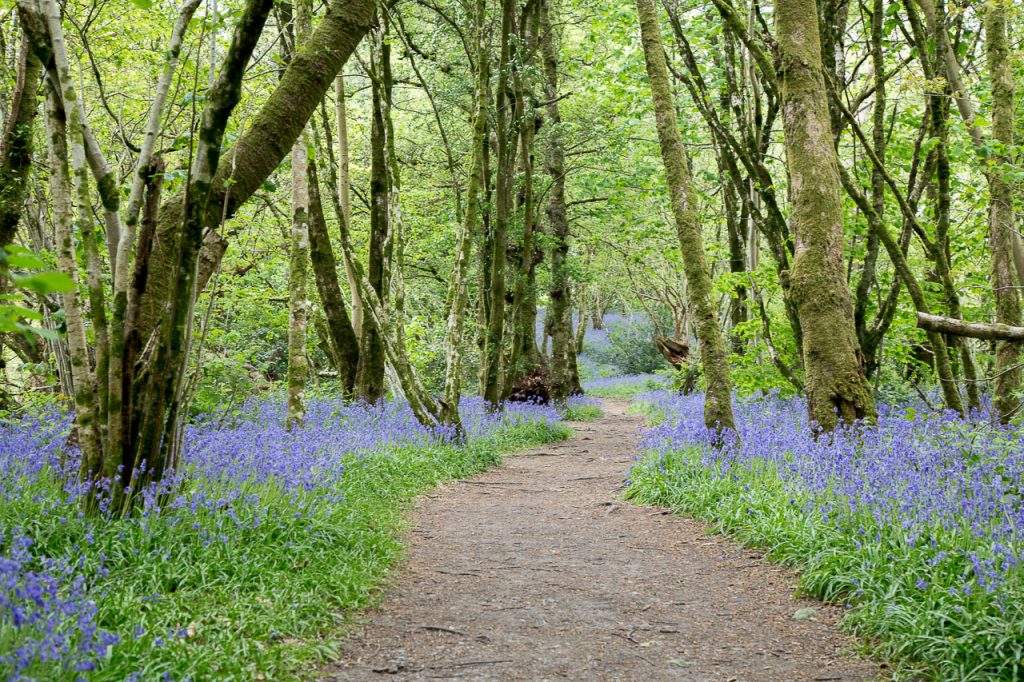
Inchmahome is a tiny island in the Lake of Menteith, which lies about halfway between Aberfoyle and Callander at the edge of the Loch Lomond & Trossachs National Park. The island is covered with trees and has a remarkable Forest Walk, but it also houses the ruins of an old 13th-century priory that sits in the center of the island.
Inchmahome, though small and only one of the scores of monastic communities that were scattered around Scotland, had some famous visitors. Robert the Bruce visited in the 1500s as did King Robert II. The most romantic visitor tales are center around Mary Queen of Scots, her mother, Marie deGuise and the “Four Marys” who served as Princess Mary’s ladies in waiting. Marie deGuise sought refuge at the Inchmahome Priory for five-year-old Mary Queen of Scots during military conflicts between Scotland and England that put the little princess’s life in danger. Old legends say that child Princess planted the Spanish Chestnuts and that those majestic trees can conjure the spirit of Mary Queen of Scots onto the island from time to time.
Two Minute Video of the Inchmahome Forest Walk – Trees Have Faces
There are many species of trees – perhaps the most famous are the Spanish Chestnuts, which are said to date back to the 1500s. They’re not easy to miss. They are the royalty of this forest and exude an energy that one can almost hear in the wind. If you relax your eyes and gently stare at these chestnuts, their aura is soon visible – gold, radiant.
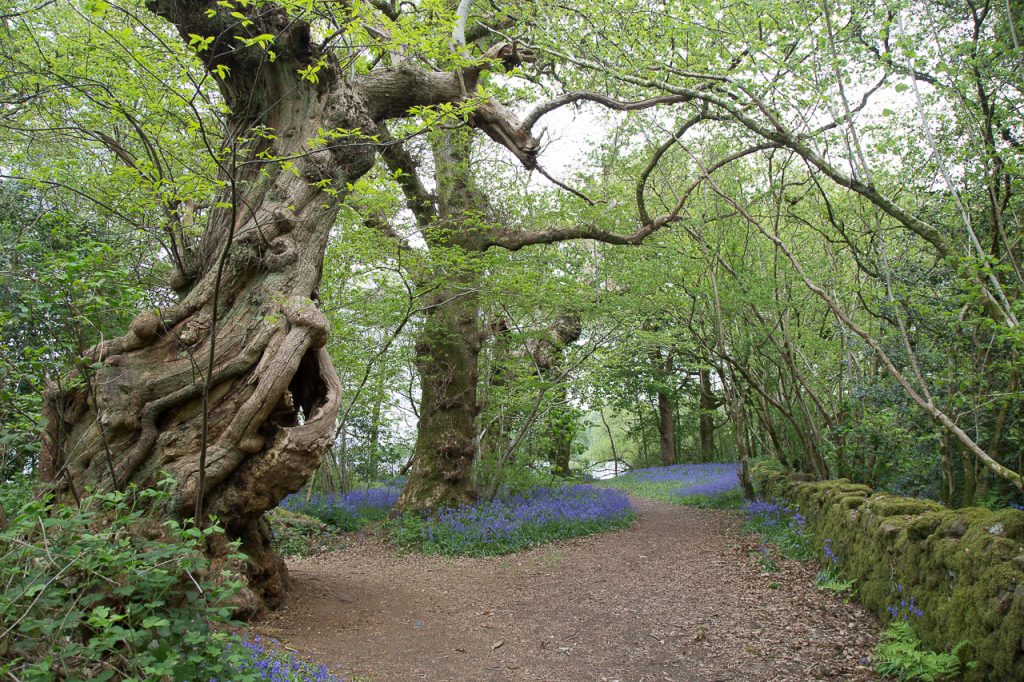
Forest Walks – Do the Trees Have Faces?
It’s interesting how fairy tales and folklore set the scariest stories in forests. Why are forests so scary? Perhaps it isn’t the forest that is scary. Perhaps it’s that our own minds that become keenly sensitive to otherworldly things when we are completely surrounded – above, below and besides – by nature, uninterrupted by development or the outside world. Something happens to our senses when we are immersed into that fury of elemental life. In fairy tales, the trees sometimes come alive – have faces – arms – and attack the forest walker… or worse.
I’ve noticed that when I walk in some forests quietly alone, after about 20 minutes I notice the details I couldn’t see before. The shapes of the branches, the colors, the textures…. and in some forests, the trees come alive with faces and human characteristics. Such was my experience at Inchmahome.
The forest became Otherworldly. It’s places like these where we can absorb the energy, the healing, the insight that comes with walking in thin places.
This little forest is worth visiting even if it’s the only thing you see in Scotland.
The Lake Hotel on Lake of Menteith
Our friends own the Lake Hotel on the shores of the Lake of Menteith and the boats that go out to Inchmahome are a short walk from that Hotel. This is where we stay during this leg of our Scotland tours because guests can savor that sense of “a thin place” for a while.
Faces in the Rock – Glenariff Woodland
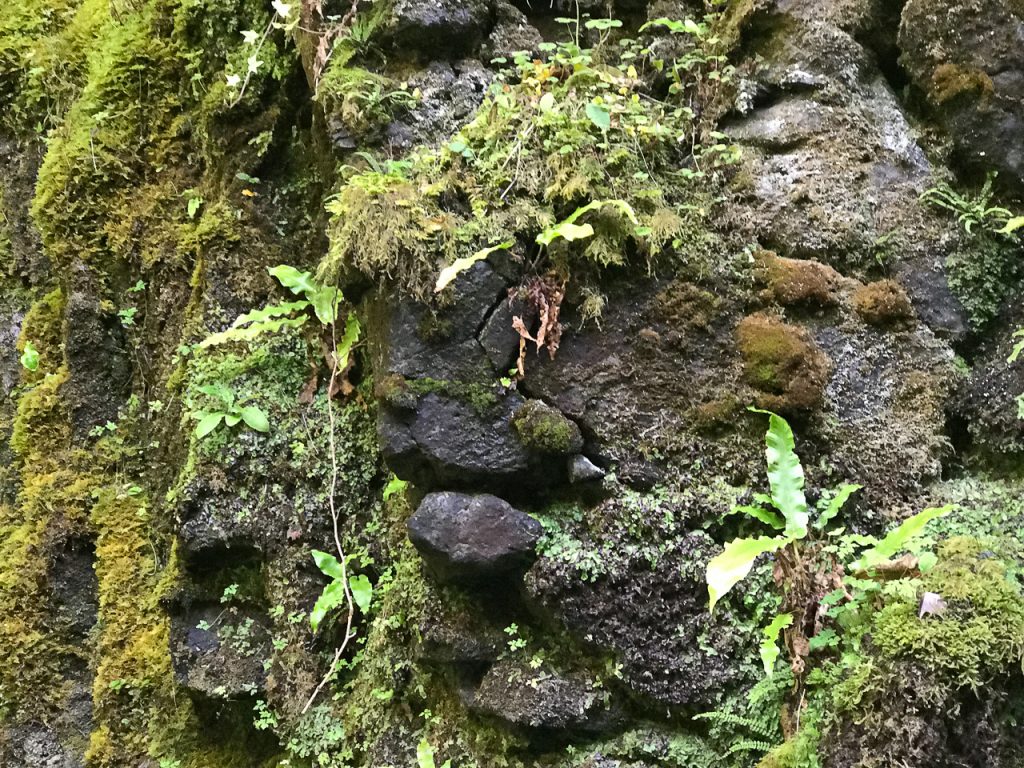 Forests and Woodlands tend to scare us. If they don’t evoke fear they at least elevate our senses. The edge is defined. We feel it as soon as we cross from the open world into a woodland. The energy shifts – changes.
Forests and Woodlands tend to scare us. If they don’t evoke fear they at least elevate our senses. The edge is defined. We feel it as soon as we cross from the open world into a woodland. The energy shifts – changes.
My friend, Wendy Mews leads tours to sacred sites in Brittany. Wendy led me through a forest near her home in Huelgoat and talked about “walking meditation.” She said that she will tell her tour guests to walk in the forest as a group – but in total silence. And she instructs her guests to notice details in that silence, to be mindful of what the forest tells them. “What do you hear in your heart? What do you feel? What does the forest tell you?”
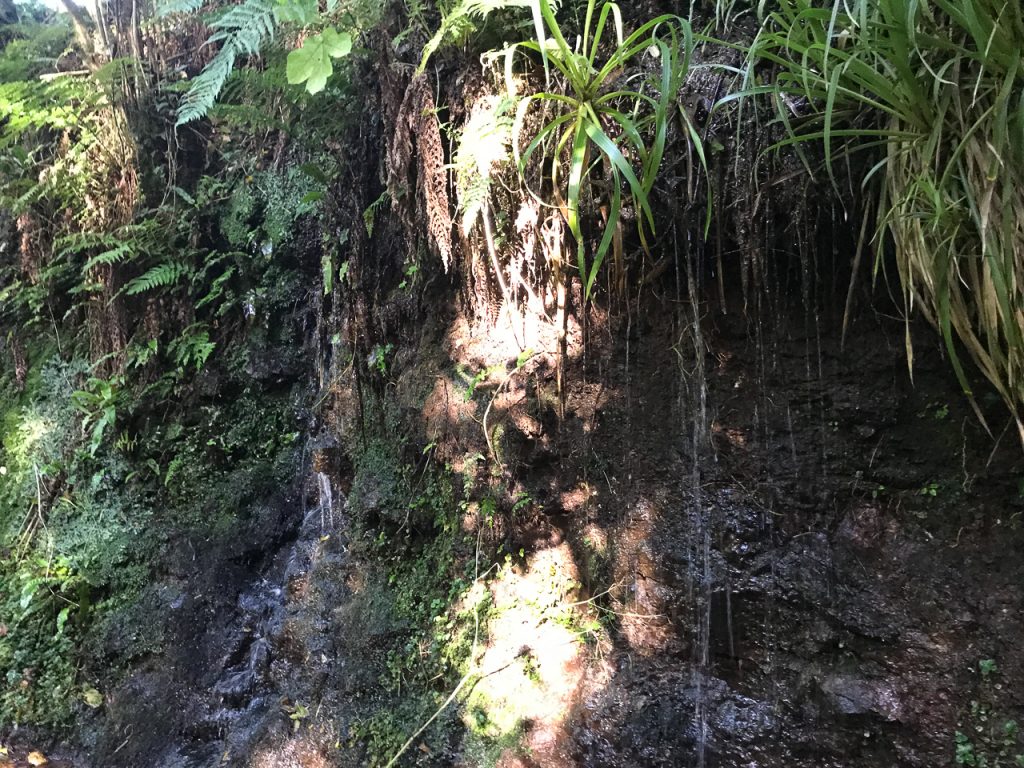
It’s funny how a chance conversation can you change one’s life. Since that conversation with Wendy, I’ve been unable to walk into a forest and not be mindful of what its telling me. I try to walk in silence…to notice details… to see what reveals itself.
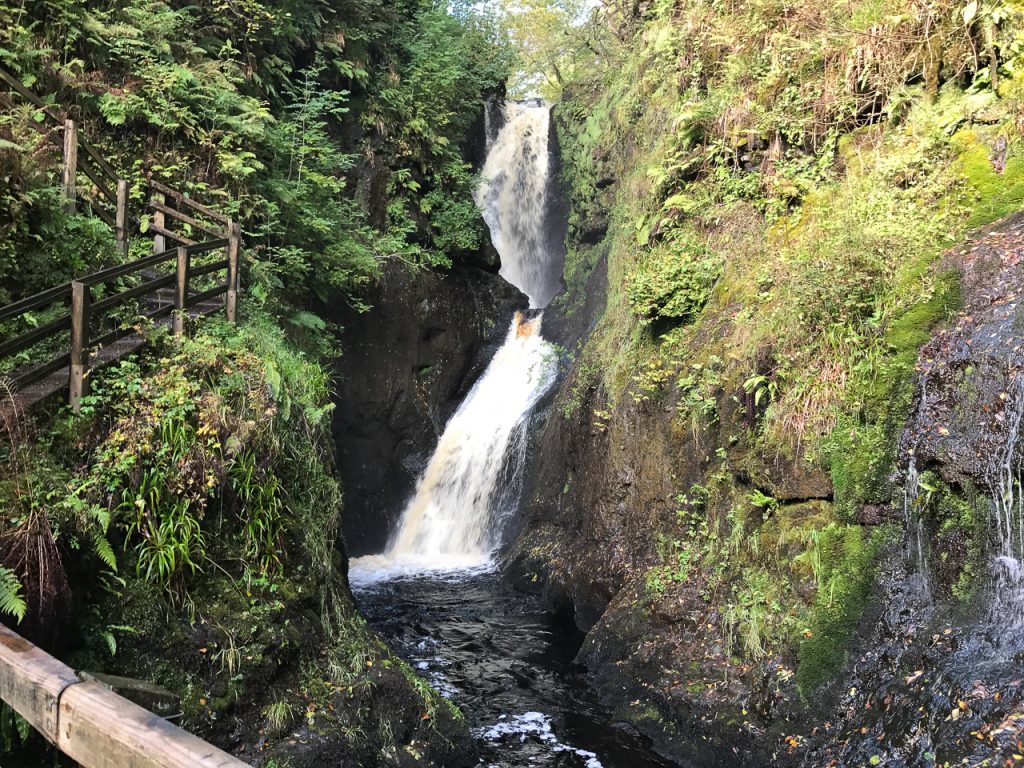
The Glenariff Woodland
In the Glenariff Woodland, there is a defined path that easy to walk. It winds into a gorge with rushing water, waterfalls, mist coming off of the rocks, all the mystical plants – ferns, ivy, holly, and a rare woodland plant known as “St. Patrick’s Cabbage.” The path is lined with oak, ash, willow and hazel trees.
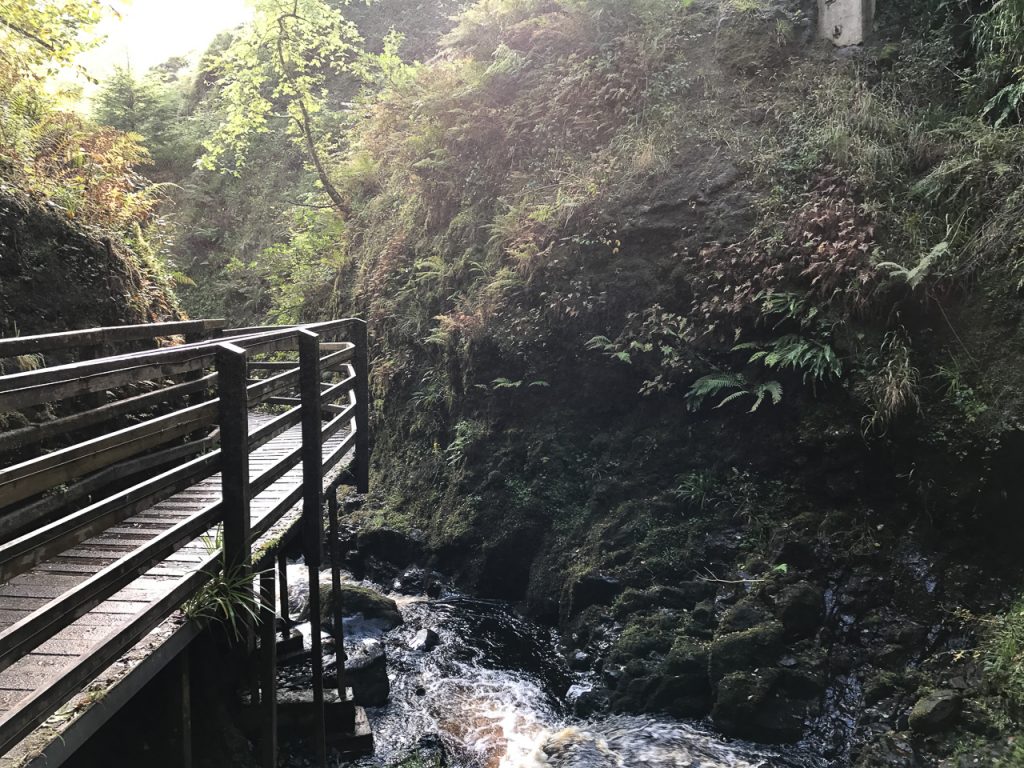
This forest was a stop on our Discover the North tour. I led my tour guests into this woodland and let them roam.
I stayed behind and then walked in silence…waiting for the woodland to speak to me.
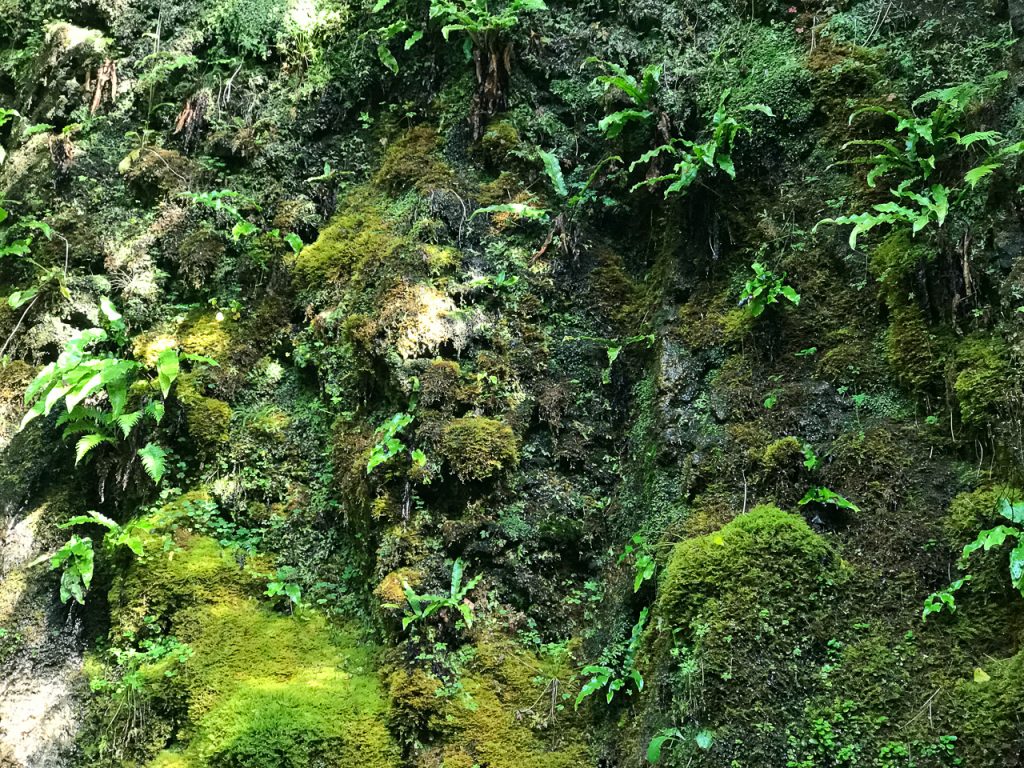
Faces in the Rock
There was a holy well along the path that had a few clooties tied to branches in the rock face.
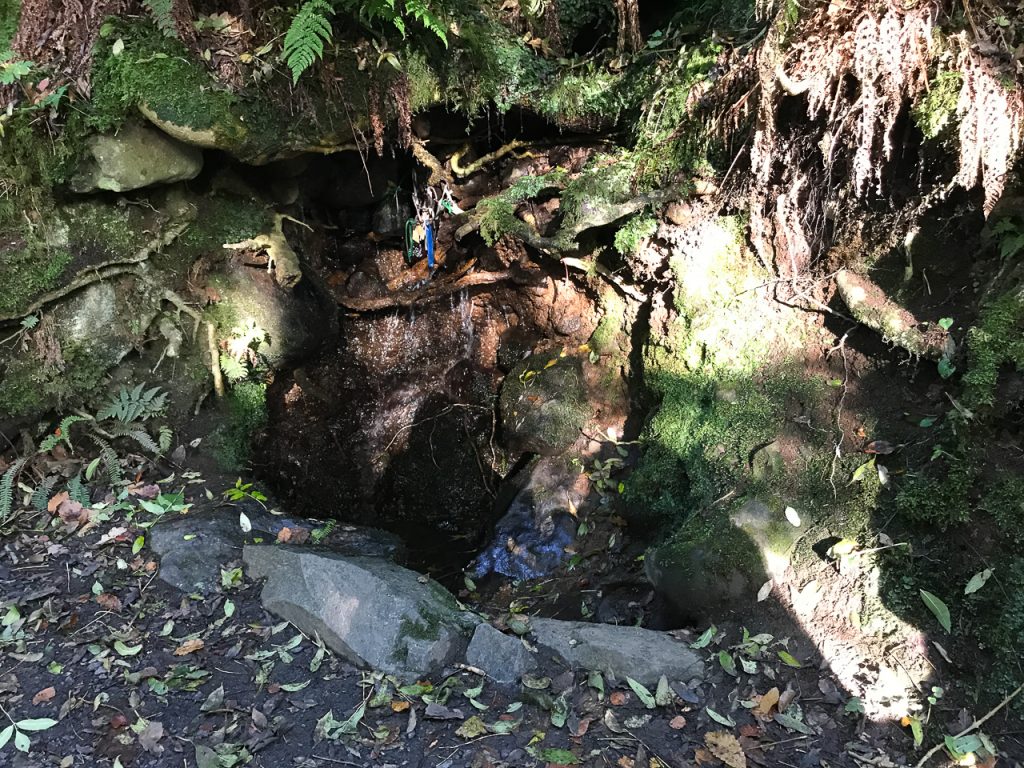 As my guests passed by me, they seemed to walk in silence too, though I hadn’t instructed them or encouraged them to do so. They were all so happy in that woodland. I stopped for a moment where the gorge wall rose steeply above the path – almost perpendicular to where we stood. In that time of reflection waiting for the woodland to “speak to me” I started to see faces – hidden in the rocks, moss, ferns and the watery surface of the gorge – – many faces. Faces made from the natural elements.
As my guests passed by me, they seemed to walk in silence too, though I hadn’t instructed them or encouraged them to do so. They were all so happy in that woodland. I stopped for a moment where the gorge wall rose steeply above the path – almost perpendicular to where we stood. In that time of reflection waiting for the woodland to “speak to me” I started to see faces – hidden in the rocks, moss, ferns and the watery surface of the gorge – – many faces. Faces made from the natural elements.
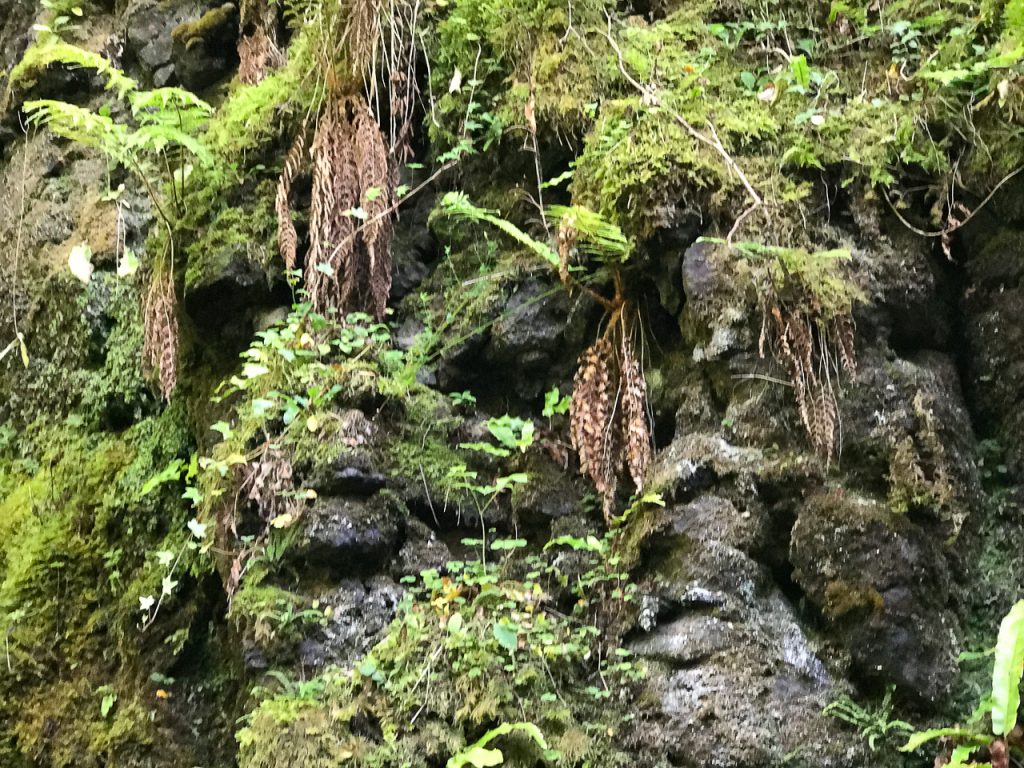 I pointed this out to my guests when they passed, and they saw them, but weren’t moved by them – not like I was anyway.
I pointed this out to my guests when they passed, and they saw them, but weren’t moved by them – not like I was anyway.
The Glenariff Waterfall Nature Reserve
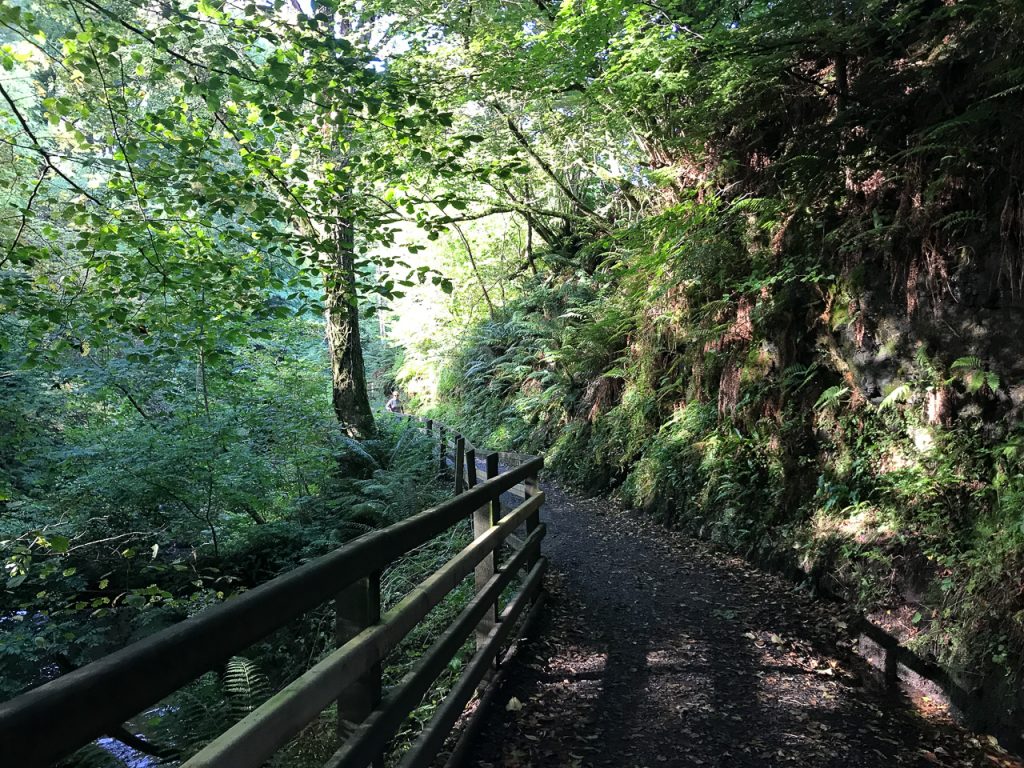
Glenariff Waterfall Nature Reserve is in the Glens of Antrim. Glenariff the largest of the nine Glens and many think it’s the most scenic. This entrance to this woodland path is located behind Large Lodge, a seasonal restaurant that has a wonderful ambiance and good food. You can park in the Lodge’s lot, have a bite to eat and then amble along the gorge path. The complete walk is about 1.5 miles and has steps and gets steep at times. But those who can’t negotiate the stairs can still enjoy the beginning of the trail.

The waterfalls and woodland are magical. Maybe you’ll see the faces.
The Glenariff Woodland Walk is on the Discover the North tour of Ireland.
A Bridge to the Otherworld – A Rainbow at Beltany
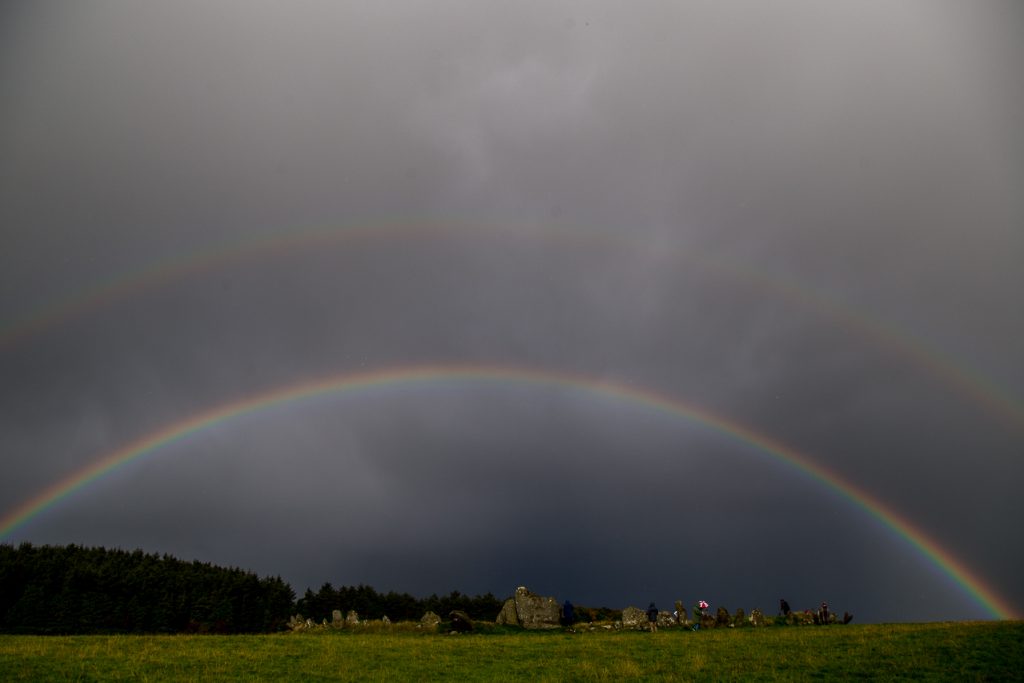
It appeared as if it was a bridge to the Otherworld… the rainbow we saw at Beltany stone circle on the eve of the Autumnal Equinox. The vision was certainly otherworldly. After seeing such a display there’s always the urge to make some kind of sense of it. To find some meaning.
Every culture has its own symbolic meaning for the rainbow. Most traditions focus on connection, a bridge to the otherworld, a promise from God, a sign of hope, a call to follow one’s heart. On the eve of the Autumn Equinox, I led a group up the path to Beltany stone circle in County Donegal. It was wet, rainy and overcast. The field approaching the circle was littered with cow dung. Several of my group turned back finding nothing particularly mystical about Beltany. But for those of us who stayed, the landscape shifted dramatically within fifteen short minutes.
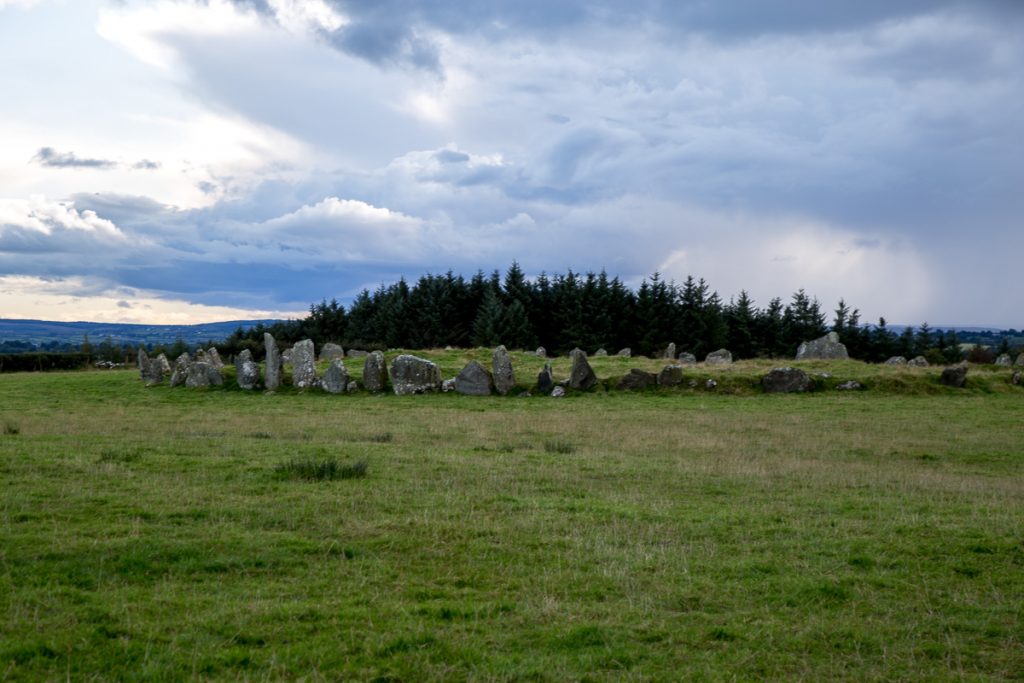
Beltany stone circle dates back to 1400 – 800 BC. With its 64 stones averaging 6 feet in height, it is larger than most found in Ireland. The circle measures about 145 feet in diameter. The site was significantly disrupted during an early twentieth-century excavation leaving the center of the circle lumpy with stones now covered by grass.
Most believe that there were at least 80 stones in the original circle. A wide triangular stone with cup markings immediately draws the eye and stands out from the others (shown to the right in the image above). It faces ENE and stands directly across the circle from the tallest stone (about six feet high) which points WSW. When the two stones align they point to the summit of a hill across the valley. On May 1st – the feast of Bealtaine – that the sun rises over that hill and aligns with these two stones. The circle’s name, “Beltany” likely refers to this celestial event and the feast of Bealtaine.
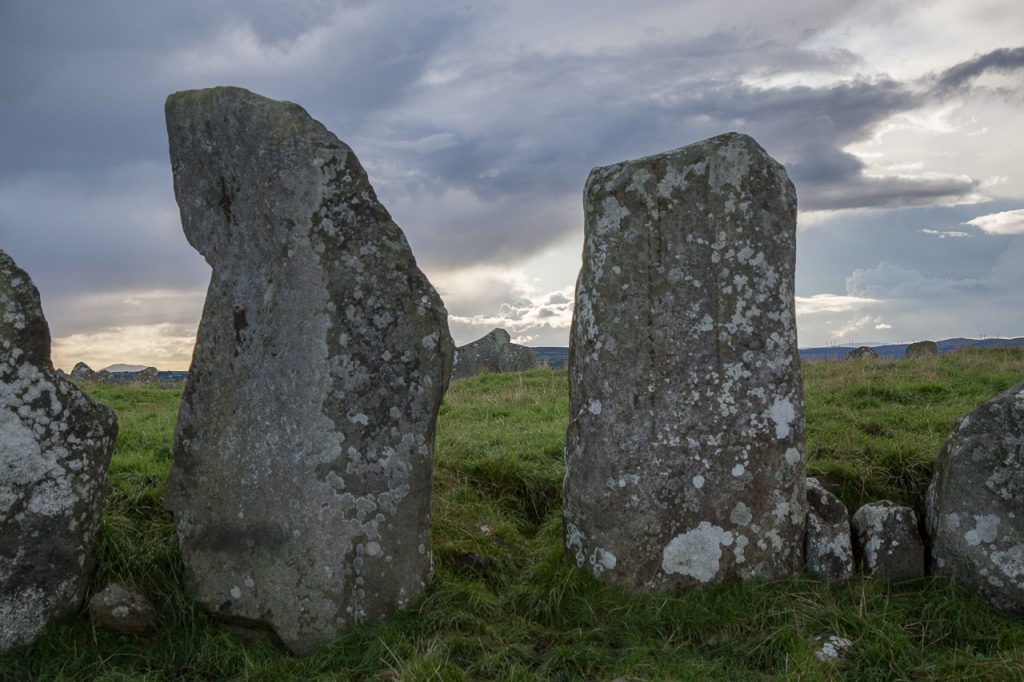
The Rainbow at Beltany
As we walked up the secluded path to the open field where the circle stands, my tour group was tired, the skies were gray and there was a slight drizzle. I was disappointed because I wanted my guest to love the circle as much as I did, but I could see that some of them remained on the bus and others exited quickly due to the difficulty of walking through a wet cattle field. I had only a portion of the tour group at the circle. Then it started to pour.
My heart sank. I want so much for this to be a perfect experience. But sometimes the weather won’t cooperate.
But sometimes the weather and the landscape surprises us.
As the rain softened, I happened to turn around toward the entrance to the field. I saw a pretty vibrant rainbow that was halfway across the sky. I called out to my tour guests to look at it. No one said a word – we just stared.
Then together we watched this rainbow spread perfectly across the sky over the circle. Then a second one appeared over the first. The clarity of the colors was stunning. Then we noticed that there was a darkness or shadow between the two bows. The space between was charcoal colored – different from the sky making the set of rainbows appear to be one thing.
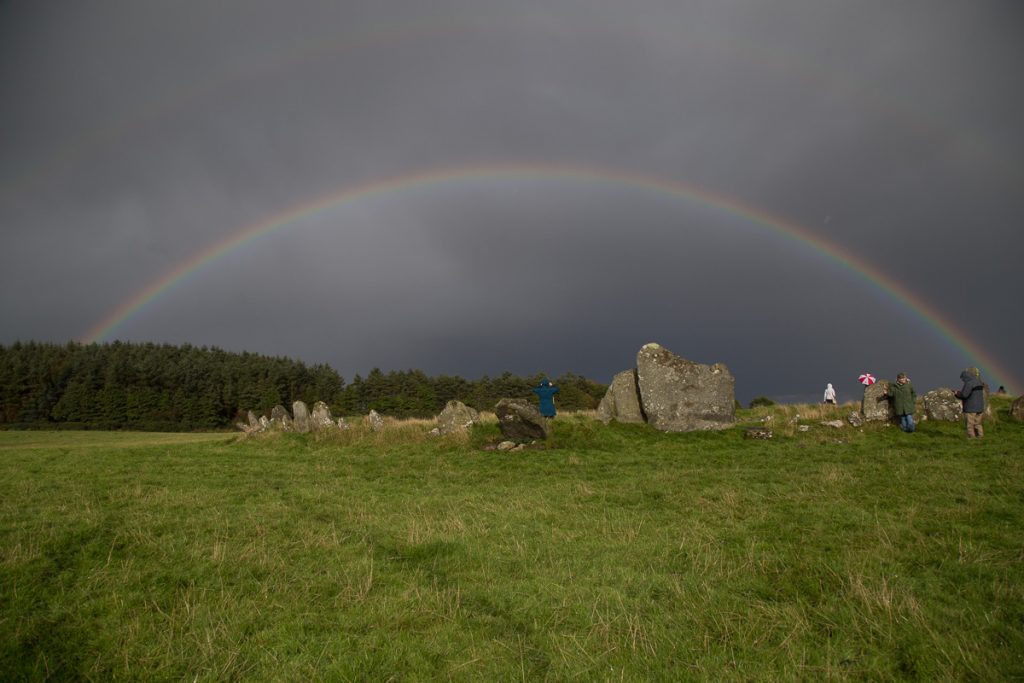
Even the sheep in the field were looking up at the rainbow.
One of my guests said, “In my seventy-one years of life, I have never seen anything like this.” It almost seemed as you could walk out to the end and touch the rainbow. Then the same guest pointed out that the colors were reversed on the second rainbow. Each rainbow was a reflection of the other with the colors going in opposite order – a perfect reflection – a mirror image. Traces of a third rainbow could be seen at the edges of the second.
The Symbolic Meanings of a Rainbow
A rainbow is a fusion of light that projects a harmonious – almost supernatural specter of all the world’s colors visible to the human eye. Every culture in every time has been moved by the sight of the rainbow. It nudges us to find some meaning in the presentation of something so spectacular. The Judeo Christian tradition is rooted in the book of Genesis.
It shall be, when I bring a cloud over the earth, that the rainbow shall be seen in the cloud; and I will remember My covenant which is between Me and you and every living creature of all flesh; the waters shall never again become a flood to destroy all flesh.Genesis 9:14-15
The first nations in North America, as well as many Asian cultures, saw the rainbow as a bridge or passage between the earthly and spirit worlds.
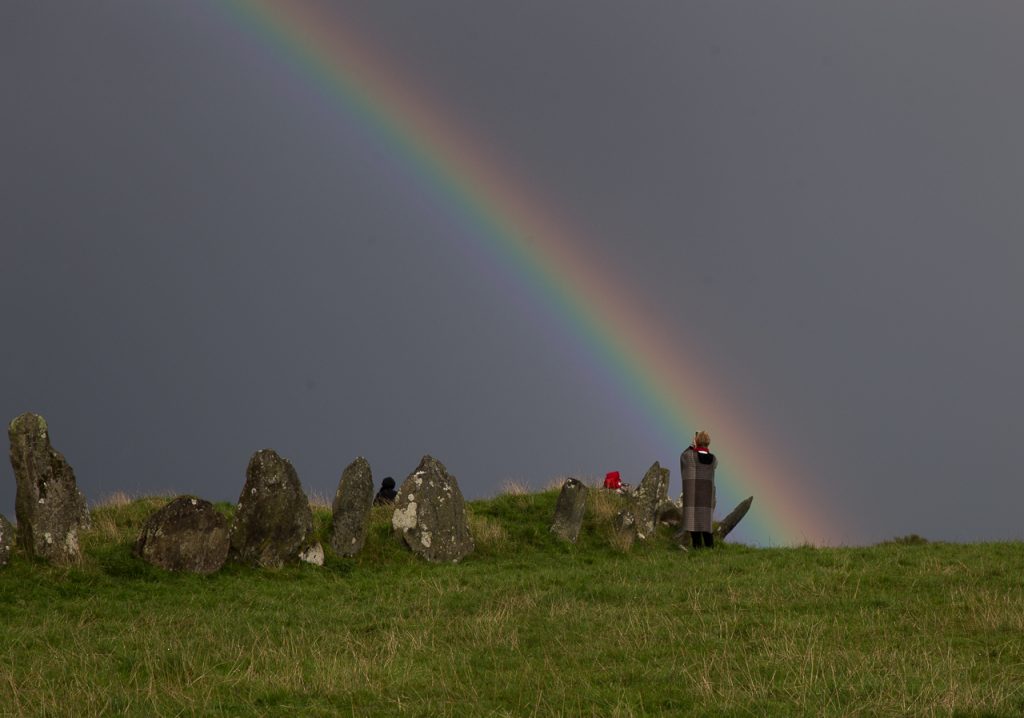
The ancient Irish or pre-Christian Irish saw the rainbow as a sign of blessing – the arc symbolized femininity – the rounded belly about to give birth, which is so appropriate for Beltany because the circle was likely created to celebrate that feast which encourages and blesses fertility and birth. The rainbow was often interpreted as a promise of good luck, abundance a sign to follow the heart’s desire or follow your dreams.
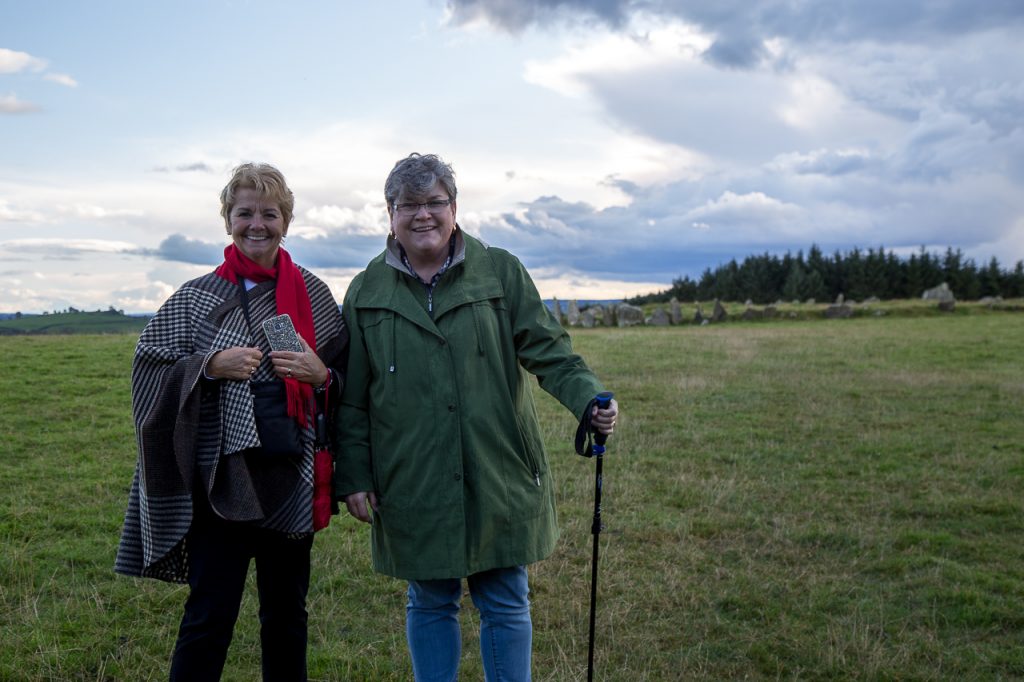
Guests on Discover the North tour after the rainbow
We’ve all heard of the old Irish saying to follow the rainbow and find the “pot of gold.” The rainbow was often interpreted as a promise of good luck, abundance a sign to follow the heart’s desire or follow your dreams. And standing at the edge of that circle and seeing the pulsing vibration of light against the field, one can perceive an actual “physical” end of the rainbow. Almost as if the pot of gold could be within reach. The light is mesmerizing.
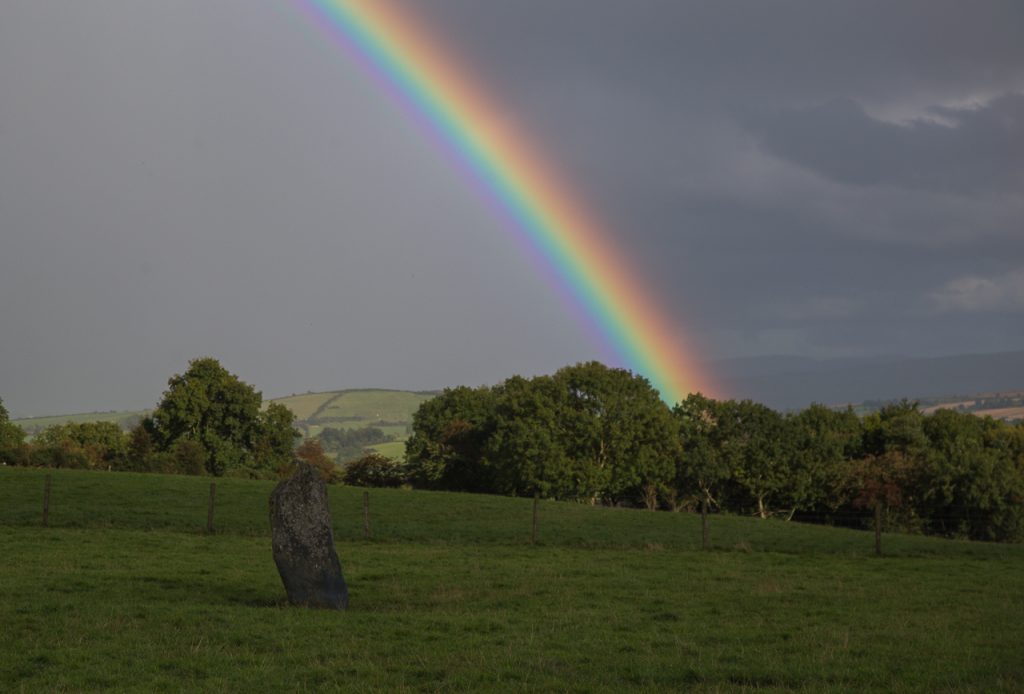
I love the kitschy words of the song from the musical Finian’s Rainbow
Look, look, look to the rainbow
Follow it over the hill and stream.
Look, look, look to the rainbow
Follow the fella’ who follows a dream
In the end, it doesn’t really matter what the rainbow means or doesn’t mean. Just standing in the presence of such a sight was gift enough for me. And it will always be a part of my memories of Beltany.
St. Gobnait – Patron of Beekeepers – County Cork
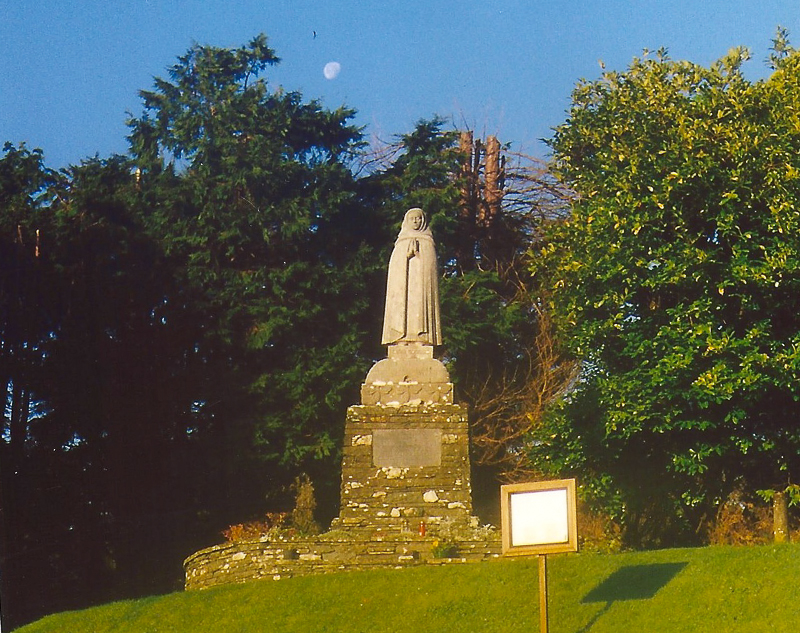
The Beekeepers’ Saint – Gobnait of Beekeepers
St. Gobnait (Irish for Deborah or Abigail), the patroness of Beekeepers and healers, is celebrated in Ballyvourney, a small town in West Cork. Her Feast Day is February 11th.

St. Gobnait, patron of beekeepers – Image by Patricia Banker
In the early 6th century when Gobnait fled her home in County Clare, she went to Inis Oírr (the smallest of the Aran Islands). We don’t know why she fled, only that she believed she would find refuge in the Aran Islands. Legend states that an angel appeared to her there and told her that her place was not on Inis Oírr, and instructed Gobnait to go on a journey – to seek her true place of resurrection. “Go until you find nine white deer grazing, ” the angel told her. “It is there that you will find your place of resurrection.” So Gobnait wandered about the southern coastal counties of Ireland – Waterford, Cor, and Kerry – searching.
She saw three white deer in Clondrohid and followed them to Ballymakeera where she saw six more. But it wasn’t until she came to Ballyvourney to a small rise overlooking the River Sullane that she saw the nine white deer all together – grazing … just as the angel from Inis Oírr had prophesied. She crossed the river and settled there. She founded a religious community for women, performed memorable – some say miraculous – works, and it was there she died and was buried.
St. Gobnait’s journey from Inis Oirr to the towns in West Cork including sites in Ballyvourney – her monastic settlement, tomb, and holy well are part of the Places of Resurrection tour.
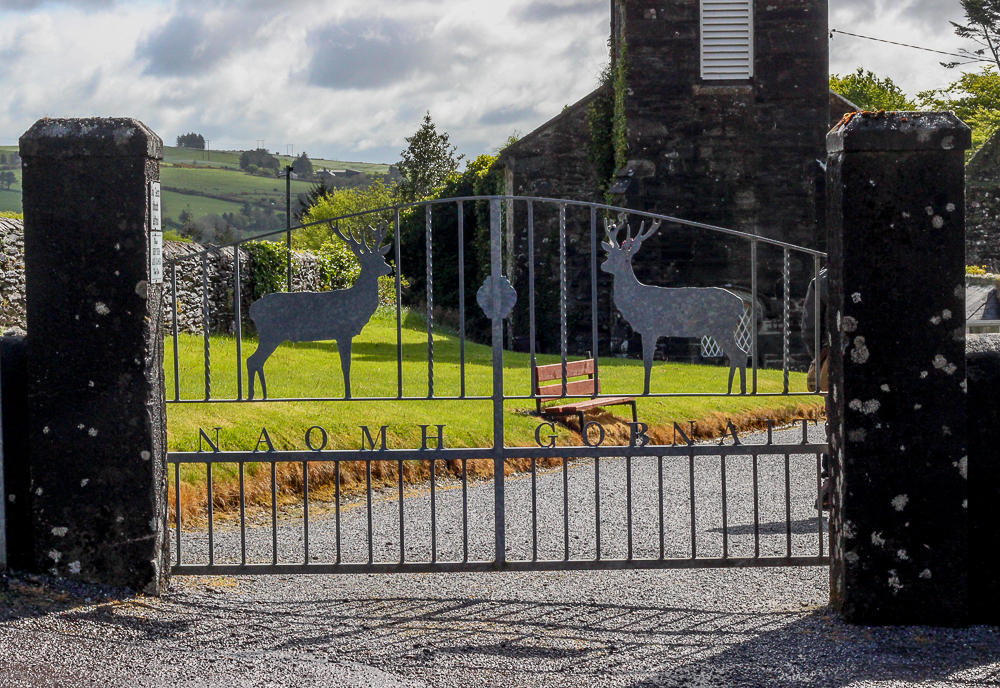
On February 11th (St. Gobnait’s feast day) she is tenderly remembered in her native region. But she has also been proclaimed by the Irish bishops to be a national saint. There are shrines and places of devotion to St. Gobnait in all the places she is believed to have stopped on her journey – including Inis Oírr. But Ballyvourney – is that special place for Gobnait… the place she felt most at home, the place where she carried out most of her ministry. And Ballyvourney is the place that draws the greatest number of pilgrims devoted to this saint.
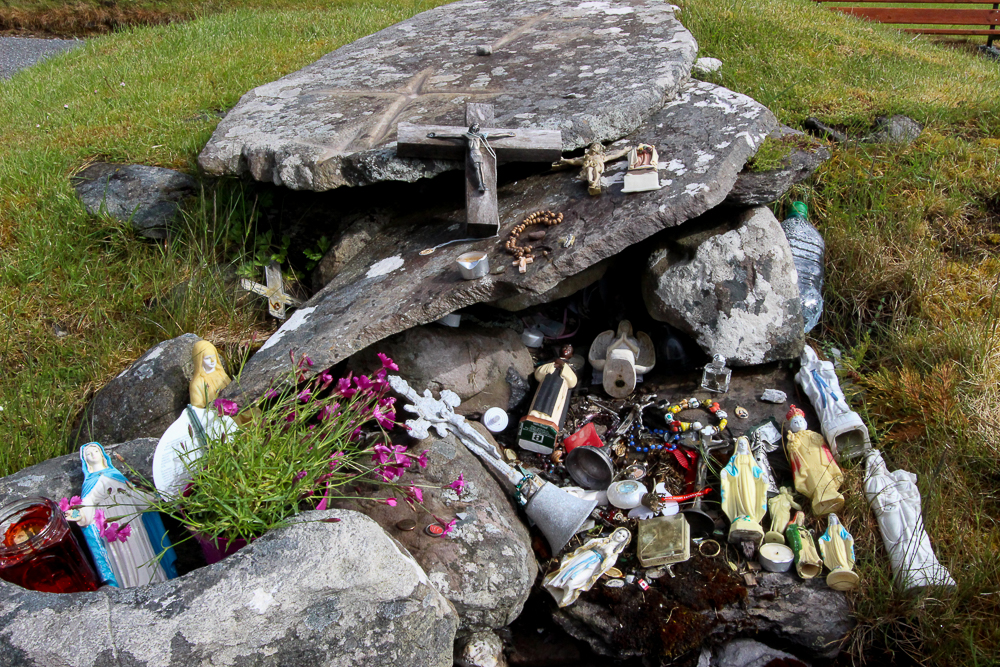
St. Gobnait’s Tomb Ballyvourney – County Cork
Today there is an active church on the former monastic site. St. Gobnait’s grave and marked spots around the churchyard are places where pilgrims pause for devotion and reflection. It is here that they can do the “rounds” or turas, always moving in a clockwise direction – a tradition that has pagan roots. One of the strongest mystical draws on this site is St. Gobnait’s Holy Well, with its arched entryway that takes the pilgrim into a deeply shaded path. Just next to the well is a sturdy tree, and hanging from it are hundreds of tokens or “clooties ” that have been placed there by pilgrims hoping to leave behind a part of themselves or loved on in need of healing. There are taps and cups available for drinking from the well or for pouring into personal vessels to take holy well water home.
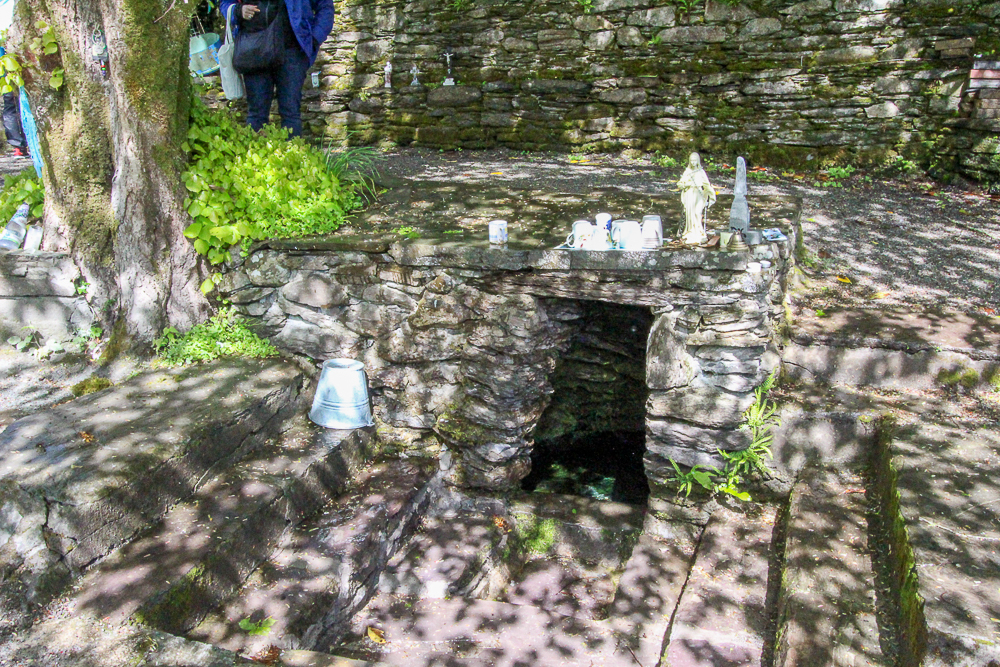
St. Gobnait’s Holy Well – Ballyvourney, Co. Cork
St. Gobnait was best known for her care of the sick. There is a legend that tells of her staving off the plague from Ballyvourney by drawing a line in sand with a stick and declaring the village “consecrated ground.” Inside the church today, there is a medieval (possibly 13th century) figure of St. Gobnait which is kept in a drawer. Every year on her feast day, the parish priest brings out the figure to celebrate a devotional tradition. He holds up the ancient figure and the faithful each step forward with a piece of ribbon. They hold the ribbon up and measure it against the length and around the circumference of the figure, then take it home as a blessed relic used for healing or further devotion.
A tall statue of St. Gobnait that was erected in the 1950s stands near the monastic site. She appears with a nun’s habit standing on a beehive surrounded by bees. Gobnait is the patron saint of beekeepers, and there are several legends recalling Gobnait forcing invaders out of Ballyvourney by setting swarms of bees upon them. It’s probable that Gobnait had a close relationship with bees and used honey in healing efforts.
PLACE OF RESURRECTION
Dan and I visited St. Gobnait’s monastic site many years ago. It is indeed, a thin place. The stories of St. Gobnait specifically mention a “place of resurrection.” I heard Dara Molloy use this phrase when referring to his home on Inis Mór and have seen a few authors reference the phrase. But regarding thin places … a place of resurrection is the pinnacle – that place where one’s spirit is totally whole, at home, with no longing or yearning to be anywhere else. A place of resurrection is not only the place where one’s spirit will resurrect from its lifeless body upon death, but also the place where that spirit is most alive inside the living body. And I believe that a place of resurrection is the spiritual home where one is most completely alive and able to create, to discern, to prophesy … to be wise.
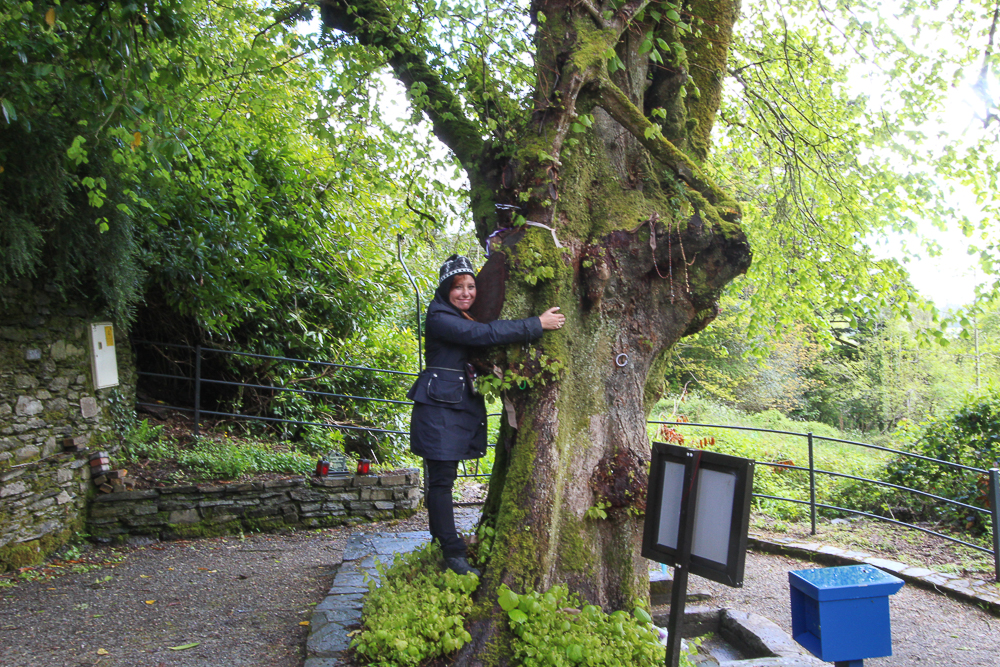
Tree at St. Gobnait’s Holy Well – Ballyvourney, Co. Cork
The connection between the eternal world and the physical is nearly unidentifiable in a place of resurrection – as they are knitted together in an inextricable pattern where neither can be separated from the other. The place of resurrection then is unto itself the combination of both worlds particularly suited to that specific spirit. … and Ballyvourney was St. Gobnait’s place.
What is yours?
Fairy Tree at Grange Stone Circle
Fairy Tree at Grange Splits Stone
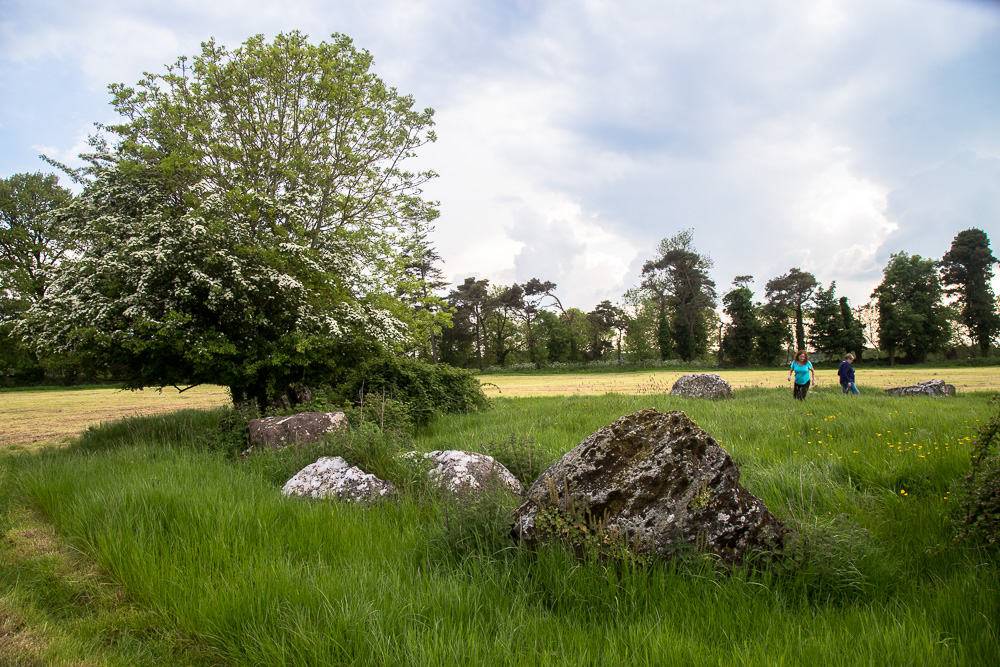
The fairy tree that split the rock at Grange Stone Circle II.
There is a fairy tree near the Grange Stone Circle has split on of the stone in two. The Grange stone circle in County Limerick is the largest in Ireland with 113 upright stones 150 feet in diameter. Many people don’t know that there is a smaller circle in the field next to the big one. And in that circle, the largest stone has a hawthorn tree growing out of it. The tree has split the stone in two and managed to thrive quite well.
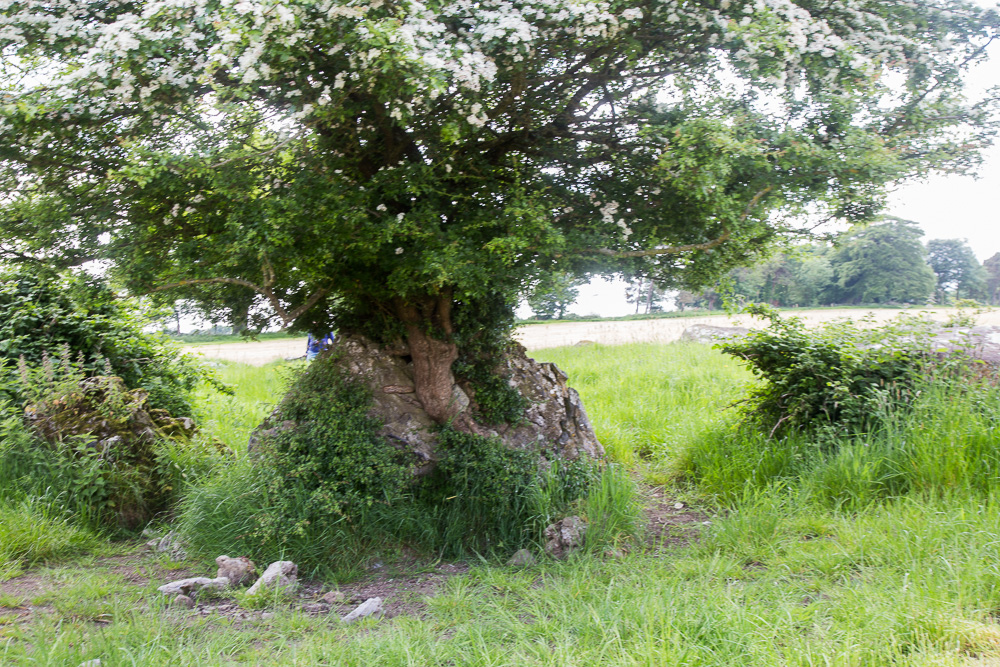
Further out in the same field is a tall standing stone and the farmer says that there’s another standing stone behind that one several hundred meters, though it is not visible to the naked eye.
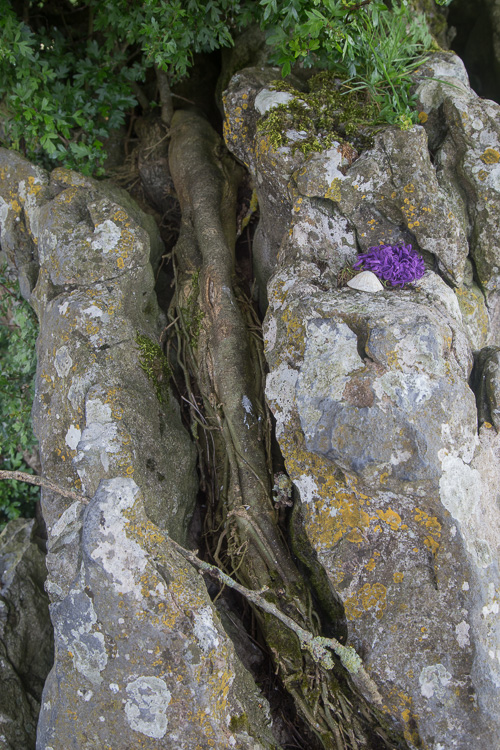
The tree growing out of the rock is said to be a fairy tree or a mystical tree associated with elemental beings (non-human spirits) of another realm or world…. kind of a parallel universe. There are many traditional folk tales about the fairies and how they don’t like being disturbed… and if disturbed will bring bad luck. Most Irish people will dismiss these tales as pure superstition, but at the same time, they won’t disturb them. There is a respect for the mystical.
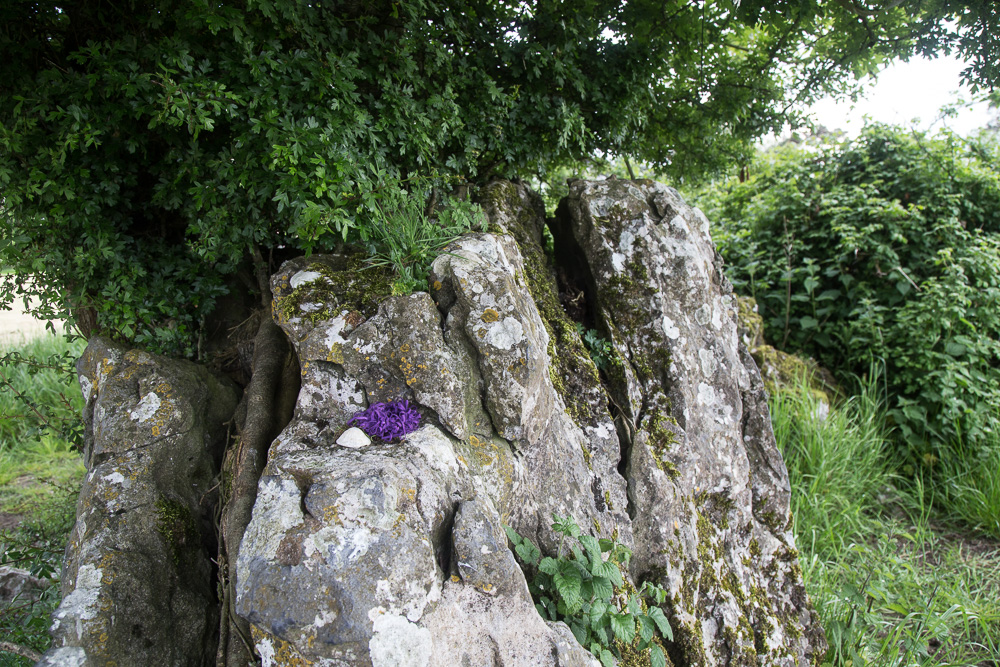
People still come to this tree and circle and leave tokens of devotion. You can see the purple ribbon and sea shell on the stone in the photo above. The entire region around the Grange and Lough Gur has an amazingly high energy vibration. I’ve taken groups there who have lost all sense of time in that place.
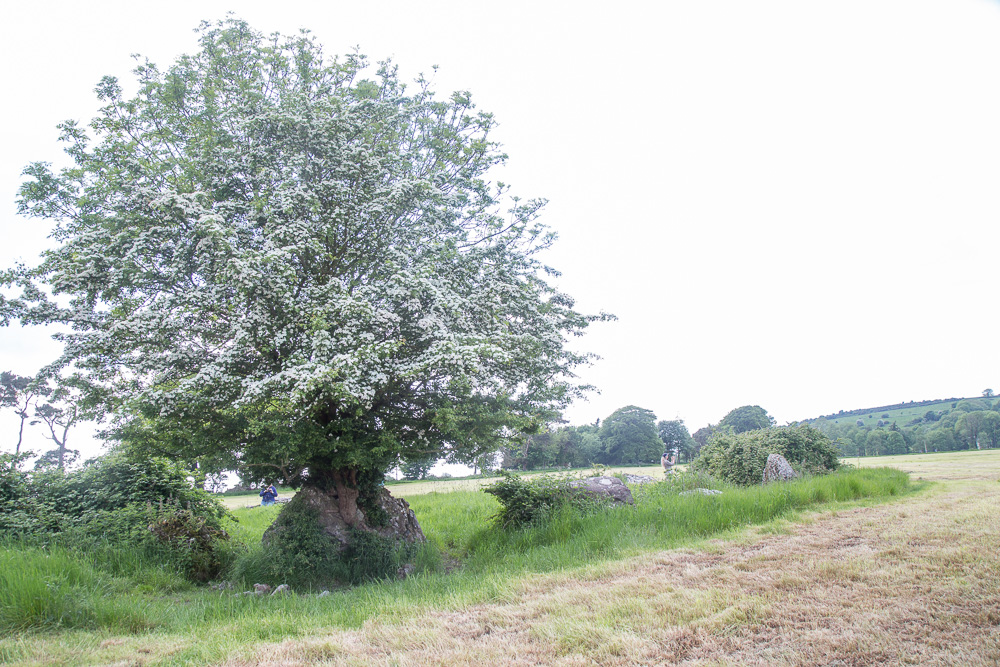
Fairy tree growing out of a rock – Grange Stone Circle II (smaller circle)
The Fairy Tree near the Grange Stone Circle and the surrounding sites are featured on the Places of Resurrection tour, Images in the Landscape Tour and Western Edges Tour.
Walking Meditation at the Hill of Uisneach
The Hill of Uisneach – a Thin Place

Guests at the Catstone on the Hill of Uisneach
The Hill of Uisneach is a thin place – one of those many luminal places in Ireland where the two worlds – physical and eternal – are fused together. It is an ideal site for being spiritually enriched by doing a walking meditation.
Few would realize as they drive along R 390 between Mullingar and Athlone, that they are passing through one of the most mystical places in all of Ireland – the mythological center of Ireland from where an ancient boulder marks the spot where all of the five provinces originate and come together… and beneath that boulder lies the goddess, Ériu, daughter of Ernmas of the Tuatha Dé Danann, earth mother of Ireland – and from whom Ireland takes its name – Eire or Erin.
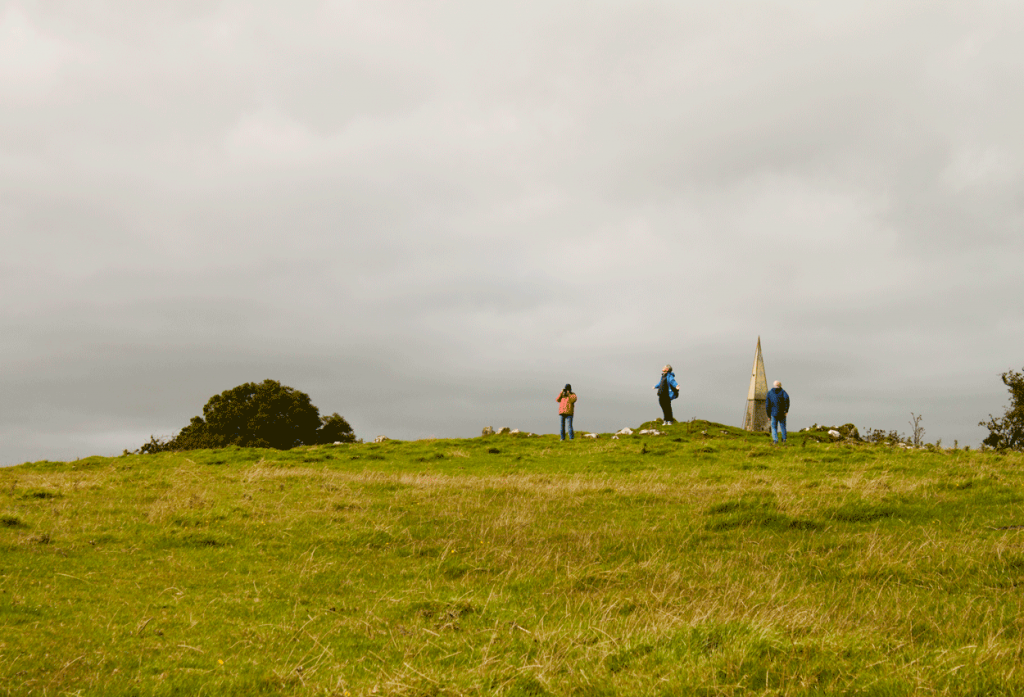
St. Patrick’s Bed on the Hill of Uisneach
From the pinnacle of the Hill of Uisneach, they say a person can see 20 counties. The Irish are always full of superlatives when they describe their archaeological treasures, but I will admit, the views are from that pinnacle – also known as St. Patrick’s Bed – are some of the most stunning I’ve seen in all my travels. The light seems to be different at Uisneach. The energy is riveting on this hill and its surrounds. And moving across this curvy greenscape of Uisneach dotted with stones, brush and lone hawthorn trees, one can see that it is a ripe setting for walking meditation.
Walking Meditation, the Process

Walking on the Hill of Uisneach
I learned about the process of Walking Mediation from my friend – and Brittany expert, Wendy Mewes. She does walking meditations with group tours that come to Brittany. The process that Wendy described is done completely in silence – even in a group. No one talks for the duration of the walk – perhaps 20 minutes.
As the walk begins, one focuses on the act of walking, moving through the landscape, being mindful of the body and the process of walking. Then one becomes mindful of the surrounding life force, noticing it in all living things around…sensing the force.. noticing that every living thing is charged with that divine presence, the presence of the creator – the great spirit – the source of all life and energy.
The third step of the walking meditation is to connect the two – your own life force with that of what surrounds you. What do the trees, the grass, the sky, the stones tell you? What do you hear from them? What do you learn from them? What are you sensing?
Sometimes, when the walking meditation is over, those on the walk discuss the experience and share what they learned, felt, were moved by, etc.
One can become totally consumed in mediation on Uisneach. The energy is overwhelming, and one can lose a sense of time and placement in the physical world. It’s no wonder that the ancients chose this spot for communal, spiritual practices. The Hill and its stories are tied to a tradition of spiritual power, rituals, traditions and mystical occurrences. It is one of Ireland’s most sacred sites.
Uisneach – site of the Bealtaine Fires

The Pinnacle – St. Patrick’s Bed – the Hill of Uisneach – The Bealtaine fires were lit near this site
Uisneach is said to be the spiritual and mythological center of Ireland – the Axis Mundi – Ireland’s naval – the joining point where all of the provinces come together in the center of the country, as well as the joining point between two worlds – the mystical and the physical. Archeological excavations show that Uisneach was likely a fire ritual site – a large one – a place where many people came together and celebrated the feast of Bealtaine.
The Catstone and Enchanted Lake

At the Catstone on the Hill of Uisneach
On the slope of the hill is Uisneach’s most famous landmark. The Aill na Mireann – meaning the stone of divisions, also known as the Catstone (so named because it resembles a crouching cat). This 30-ton limestone boulder that stands 16 feet high sits solitary on the lonely hillside. It was believed to not only mark the intersection of all five of Ireland’s provinces, it’s also said to mark the grave of Ériu, the mother goddess of Ireland, the one whom Ireland – Eire – is named for.
Uisneach was also said to be the site of one of the five great trees of Ireland – The Uisneach Ash – planted by Fintan the Seer who is said to have divided Ireland into its provinces with the stone at the dividing point – calling for there to be knowledge in the west, battle in the north, prosperity in the east and music in the south with royalty in the center. The Stone of Divisions. Since the stone touches every province, it also shares each province’s virtues. Thus we have the concept of all provinces meeting at Uisneach, and it being the mystical and mythological center of Ireland.
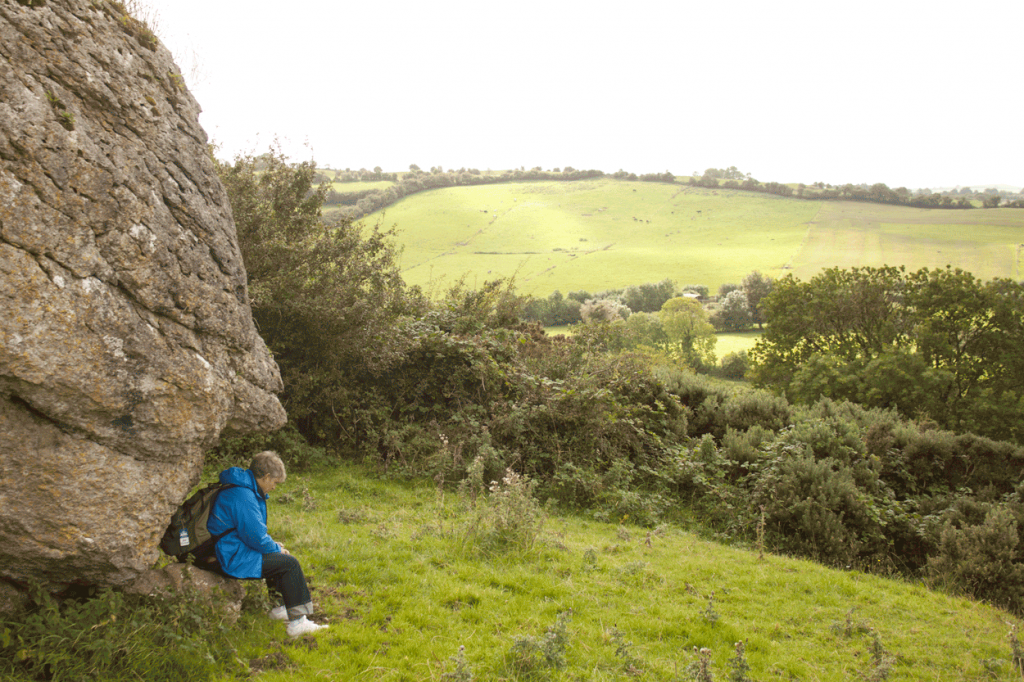
Sitting on the Catstone at the Hill of Uisneach
There have been people tracking ley lines throughout Ireland who see a common pattern with many lines leading to Uisneach. High Kings were once crowned at Uisneach before the Hill of Tara became the royal center for the country. So the legendary mystical character of the site goes back thousands of years.
There is a small (some believe enchanted) lake on the hill dedicated to Lugh, a member of the Tuatha Dé Dannan also known as the sun or harvest god. Legend states that Lugh battled with his brother on this hill and was drowned in the lake and buried under a nearby mound. Some believe the lake is enchanted.

Lugh’s Lake on the Hill of Uisneach
Not too far from Lugh’s Lake is the foundation of the old palace that sat atop the hill. Located in one on those grounds is another stone – nicknamed “the money stone.” It’s short and appears to have petrified wood drilled into it. The stone has amazing energy, and if you place your hand a few inches away from it, you can sometimes feel the energy coming off of it in the form of heat or a vibration. Using dowsing rods on the hill, we found the magnetic pull coming – not from the Catstone, but from the money stone. I’ve not been able to trace the origin of the name of that stone but can encourage people to seek it out.

Under the Fairy Tree – Hill of Uisneach – Images in the Landscape Tour 2015
Considering the ancient fire rituals, royal traditions, legends of the goddess, the Capstone, Money stone and enchanted lake, Uisneach is truly a mythological mecca for those who seek out thin places. A walking meditation here, is powerful food for the spirit.
Discover the North Tour 2016 Begins with the Blessing of St. Brigid

Statue of St. Brigid at Tobar Bride – St. Brigid’s Holy Well in Kildare
The 2016 Discover the North tour started in Dublin today as our 18 guests arrived at Dublin Airport from many parts of United States and Canada. One of our favorite places to take guests on the first day is to Solas Bhride – a center in Kildare run by Brigidine sisters who provide a warm welcome and the blessing of St. Brigid.

Sr. Phil talks about the tradition of the St. Brigid’s Cross at Solas Bhride
Our guests gathered for the first time as a group today at 1pm for a short meeting. Then we boarded our bus in the rain. It was a damp, dreary day. But the dismal atmosphere lifted when Sister Phil and Sister Mary met at the door of this Christian spirituality center that welcomes people of all faiths and of no faith within the context of the Solas Bhride vision to unfold the legacy of St. Brigid and its relevance for our time.

Sr. Phil weaves a St. Brigid’s Cross – Solas Bhride
I can’t think of a better place in Ireland for bringing people together for the first time. After a brief tour of the center, Sister Phil arranged the group in a circle and wove a cross of St. Brigid. With each rush she wove into the cross, she asked the group what they would like to “weave” into their journey this week. As members of this newly formed tour group called out things like friendship, forgiveness, humor, love, respect, St. Phil added a rush to the cross – each rush representing a hope for the journey. At the end she presented me with the cross, and we’ll keep it on the bus in plain sight as a reminder of the blessings received at Solas Bhride…. as we move through these coming days together.

Sr Phil presents the cross to me (Mindie Burgoyne)
The traditional blessing of the St. Brigid’s Cross to be hung in the home is:
“May the blessing of God and the Trinity be on this cross, and on the home where it hangs and on everyone who looks at it”
So we’ll shift that bit and substitute the word “bus” for home and keep at a point of focus on our journey together.
After Solas Bhride (means the light of Brigid), we went around the corner to “Tobar Bride” – St. Brigid’s holy well – a site of local pilgrimage where the water from a holy well runs out to little spring that flows around a small island with a bronze statue of St. Brigid holding a crozier and a flame. (see image above) The peace is palpable in this place.

Clooties on the tree at St. Brigid’s Holy Well – Kildare
There’s a clootie tree by the well (sometimes called fairy tree or rag tree) where pilgrims leave tokens of devotion – something that represents an intention left behind. Today was an interesting array of clooties.
I still believe that every person on our thin places tour was called to that particular tour for a reason. We all have been called to be a collective part of the “whole” that will make up this tour. The first day is always a prayerful time for me. I pray everyone is blessed, inspired, enlightened and celebrated.

Part of our Discover the North 2016 tour group at the welcome dinner in Dublin
So Dan and I welcome you all – Julie, Suzanne, Karen, Richard, Cheryl, Don, Tricia, Anita, Marianne, Kathy, Moyra, Karen, Eleanor, Sally, Jen, Ann, Ruth and Danny.
Here’s to Ireland, new friends, new discoveries and thin places.

